
If you were wondering what to do in Mexico City and did not know where to start you arrived at the right place.
After spending several days in the capital, I came intimately close to all of the best things to do in Mexico City, from the many museums, some of which are pretty unique, to all things Frida Kahlo and Diego Rivera, to the Mexica ruins and pre-Hispanic archeological sites. The city has a lot to offer.
Mexico City is a huge urban area that expands several thousand square kilometers and is home to just below 9 million people. When you include the metropolitan area, which has several of Mexico City’s attractions, you get closer to 21 million people.
The city’s uniqueness is not only in its large size but also in its geography and location. Mexico City is a high altitude capital located in a valley at about 2,250m above sea level and surrounded by volcanoes.
Historically, Mexico City was the Mexica city of Tenochtitlan and was built on a platform over the Lake Texcoco. The Mexica, also known as the Aztecs, supposedly built the city where they spotted an eagle on a nopal cactus eating a rattlesnake.
This was what their god Huitzilopochtli prophesied, stating that when the sign appeared they should start a new city, bringing their long 200 year journey to an end. This has become the symbol of the city and it appears on the country’s coat of arms and flag as well as on its coins and many other government buildings.
Mexico City, Ciudad de Mexico or Distrito Federal?
The first thing that you may notice when you visit Mexico City is the fact that the city changed its name from the previous Distrito Federal, or Federal District, abbreviated as DF in 2016.
The new name has given the city its own identity as Ciudad de Mexico, abbreviated as CDMX and translated as Mexico City. The rebranding is obvious across the city with signs, ads and government institutions all bearing the CDMX acronym.
The change was made by the Mexican President, Enrique Peña Nieto, to give more autonomy to the federal government and it is said to have informally started after the 1985 earthquake that destroyed much of the city and evidenced the lack of response of the central government. The move also turned the city’s 16 boroughs such as Coyocan, into municipalities.
If you are wondering how you call the residents of Mexico City, they are called Chilangos.
Best museums in Mexico City
One of the best things to do in Mexico City is exploring the dozens of museums. It is said that the city has so many that you could visit a different one every other day and not finish them all in a year.
While I could not find an accurate source for the count, most figures I have seen placed the number of museums in Mexico City between 150 to 180.
Needless to say, visiting Mexico City and not spending a relevant amount of time at the two key museums would be a crime, but there are also a lot of smaller and really niche ones that are devoted to really specific things and make for a fun couple of hours.
The only thing you need to know about the city’s museums is that almost all of them close on Mondays, and that Sundays are free for locals, so museums pack your time to the brim. Avoid those two days and you will have a great experience. Even the Anthropology Museum does not get too crowded on other days of the week and can still be enjoyed leisurely.
Palacio de Bellas Artes (Palace of Fine Arts)

This stunning building is one of the most recognizable Mexico City attractions and its roof and design often appears as the city’s emblem and most representative landmark. It is also UNESCO listed since 1987 for its cultural value.
The palace was meant to commemorate Mexico’s independence centenary in 1910 but war and financial difficulties delayed its completion till 1934. Visiting Palacio de Bellas Artes should be on your list of the best things to do in Mexico City.
The building itself is worth a trip on its own right but the interior also hosts important art pieces. The fine arts section is almost entirely focused on murals by Mexico’s most famous muralists, Diego Rivera and his contemporaries and disciples, David Alfaro Siqueiros, José Clemente Orozco and Rufino Tamayo. It is common to see school groups learning more about these Mexican artists.
Diego Rivera’s large mural “El hombre controlador del universo” (Man at the Crossroads) is a continuation of his work for the Rockefeller Center, which was destroyed after he introduced a picture of Lenin in it and was made exclusively for the Palace.

Rivera was a known socialist and this political theme always transcended into his murals, with representations and overt criticisms of capitalism and the government. Other murals were transferred to the Palacio Bellas Artes for safekeeping and display, although they were made for other purposes.
Jose Clemente Orozco also painted murals exclusively for the Palace and his largest is La Katharsi, where he represents war and criticizes the culture of the masses. Its name was given later based on the interpretation of the fire on the top part by one of his historians, Justino Fernández.
David Alfaro Siqueiros’ triptic called Nueva Democracia (New Democracy) represents the Ally win in WWII. Note how Siqueiros painted beyond the borders of the mural.
He also painted murals to the indigenous ruler Cuauhtémoc. In those, look out for La Malinche, an indigenous face among the armoured Spanish soldiers, Cortes’ translator and later wife.
Rufino Tamayo’s murals are more abstract, less defined like Siqueiros, and he represents the Conquista in a more blurred out manner. His mural shows that the reality after the Spanish arrival was a new reality after the destruction.
Because Bellas Artes took over 30 years to be completed and the architect changed, its style is a bit of a mix and match.
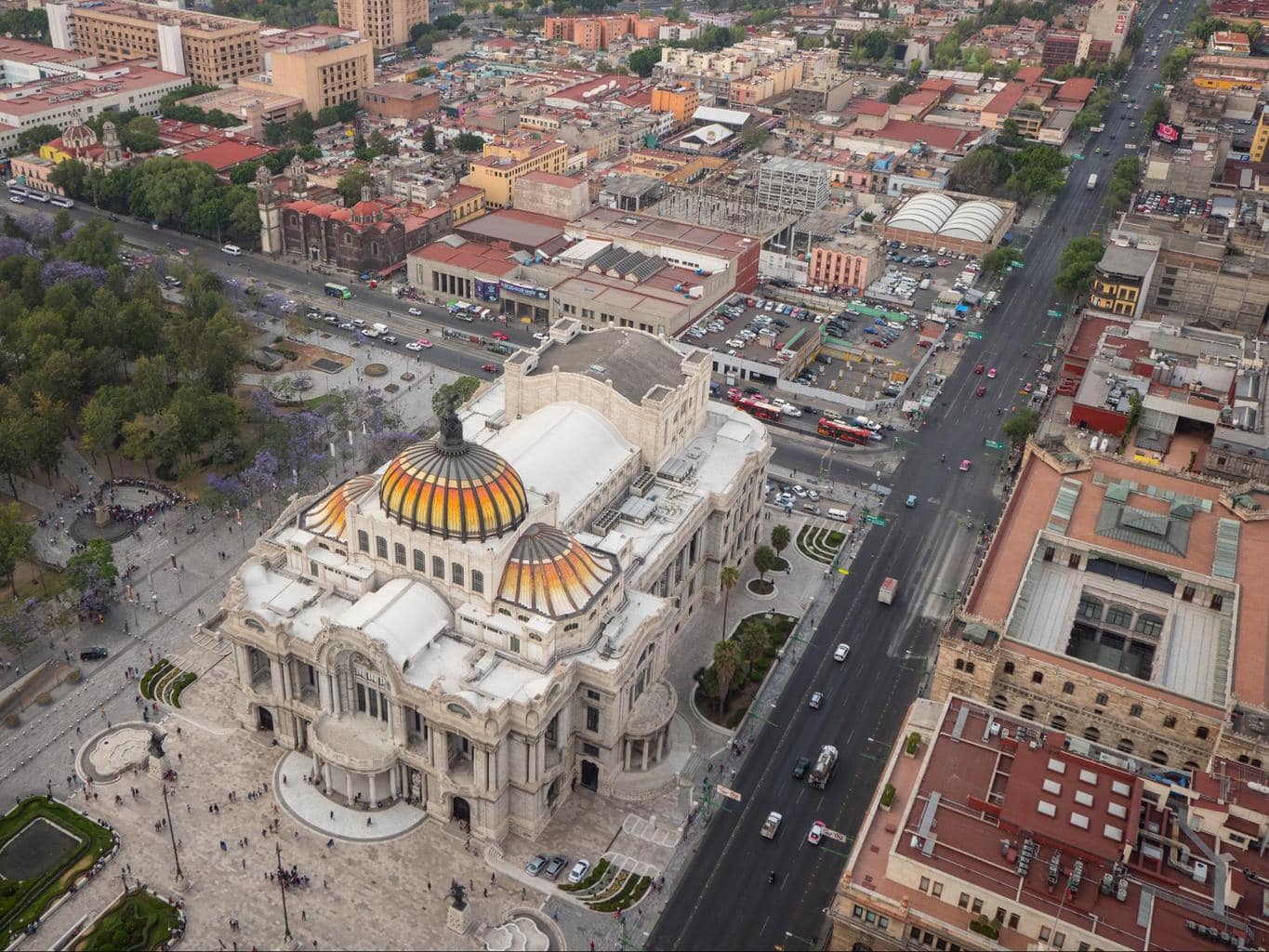
Outside, you will see an Art Nouveau marble facade designed by Italian architect Adamo Baori, with glittering yellow and orange ceramic tiles topping a large dome. This part was finished before the Revolution, except for the dome.
The palace was practically abandoned from 1917 until 1928 when a new architect, Federico Mariscal, was assigned to complete the building. As the world moved away from Art Nouveau to Art Deco, the palace’s interior is decidedly in the new artistic movement with straight lines and arches and metal elements.
Aside from the National Museum of Architecture, the palace also plays home to the original National Theater with regular ballet, opera and classical music performances. Its curtain is made of thousands of pieces of Tiffany’s glass and is stunning.
Because of the city’s ongoing sinking issues (ancient Mexico City, Tenochtitlan, was built over a lake and today’s modern city still is), the palace is said to have sunk over 4m since its construction already.
Tip: the best view of the building’s dome and architecture is from the Torre Latinamericana (Latin-American Tower) from where you can have a bird’s eye perspective. Take a tour of Mexico’s best monuments including the tower (with tickets) here. More information here.
Museo de la Ciudad de México

This museum is housed in the Baroque 17th century mansion and former home of the Count of Santiago de Calimaya and was acquired by the government in the 1960s to be turned into the museum of the city.
Here you can learn more about the rich past of Mexico City from pre-hispanic Tenochtitlan times till today. You can also visit the rooms of this former noble family some of which have been kept intact.
More information on the museum can be found here.
Museo Nacional de Antropologia
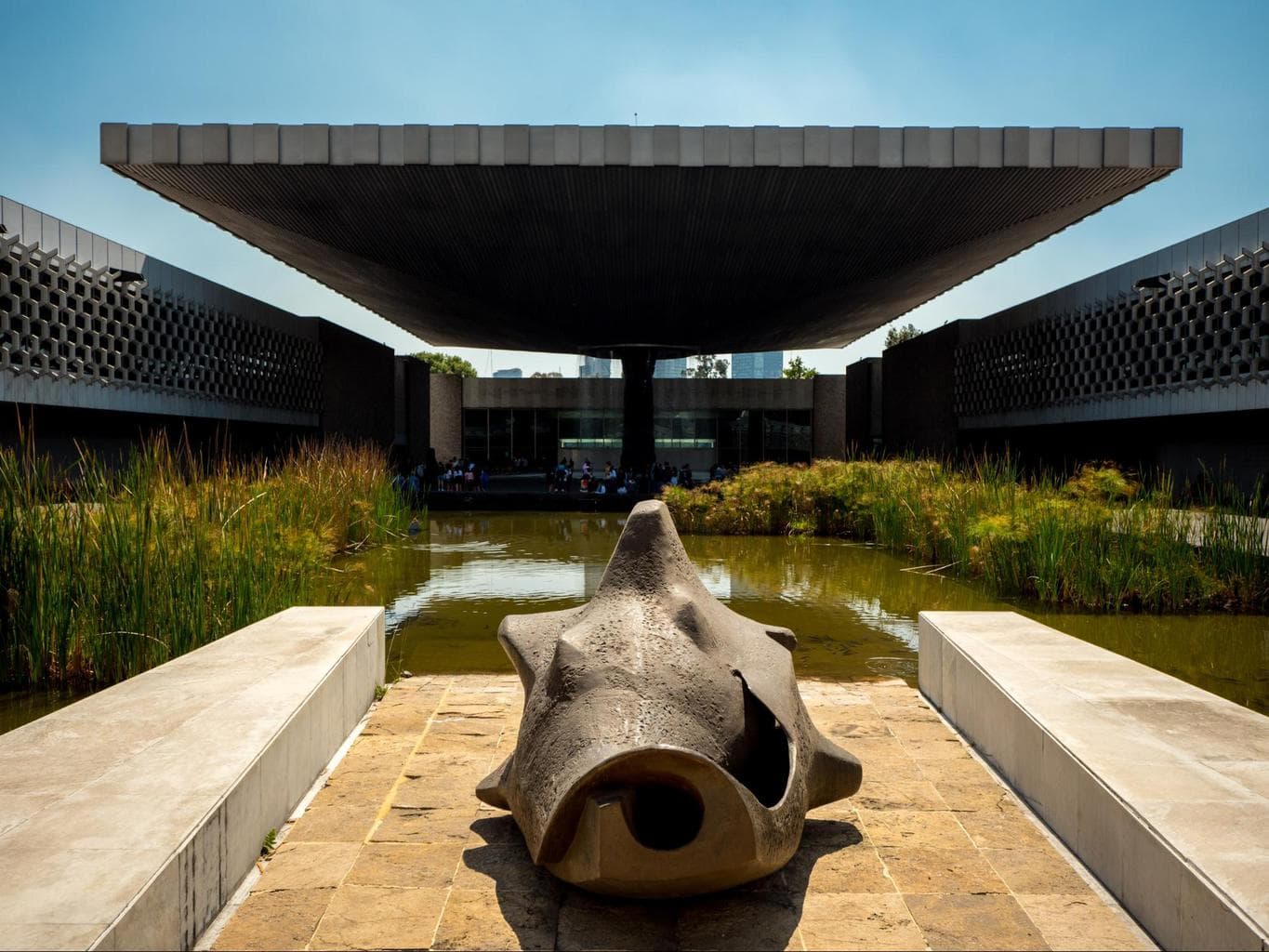
The Anthropology Museum is the 7th largest museum in the world and it’s easy to get lost in its many rooms. I actually spent almost an entire day there, from morning to evening including lunch. More than 2.5 million people visit the museum every year, although the National Museum in Chapultepec Castle received slightly more.
Its collection of Pre-Hispanic art is one of the most extensive with objects from all civilizations from across the country. Thanks to its easy to navigate layout, with all the rooms set around a large courtyard with the famous umbrella waterfall and split into two floors, the museum is a pleasure to explore.



The museum opened in 1964 and gathers objects from all the archeological ruins as well as an introductory hall with the history of humankind that sets the scene. The space is organized in chronological order and in the later rooms you can also learn more about the indigenous groups in Mexico today.
Apart from the museum, the complex also has a fantastic restaurant with an outdoor terrace area where you can enjoy dishes from all parts of Mexico. There is also a great shop.
The Blue House – Frida Kahlo Museum
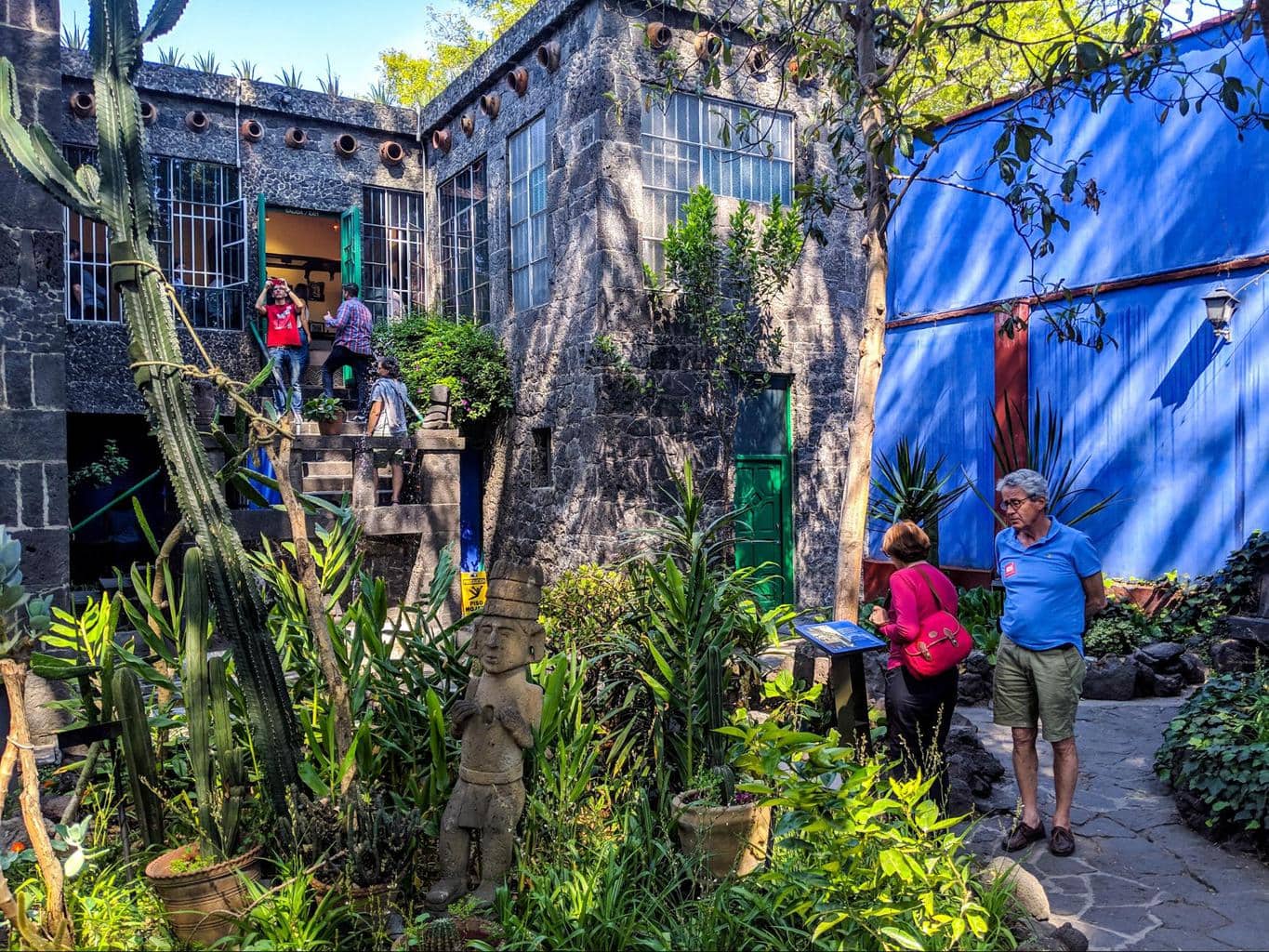
Visiting this small and always packed museum in the southern part of the city, in Coyoacan, is one of the most popular things to do in Mexico City for visitors.
Anyone visiting Coyoacan, or even the city, has the Frida Kahlo museum on their list of the most famous Mexico City attractions. It is not uncommon to find a line snaking around the corner with people waiting for their turn.
The lines are caused by the museum’s popularity and by its small size which requires the number of visitors to be controlled at all times and even then, it often is so crowded inside that you can barely walk through the tiny rooms.
This is the house Frida Kahlo was born in and where she died and it opened as a museum four years after her death in 1954. She lived in many other parts of the city and abroad during her marriage to Diego Rivera but the house always remained a place she returned to.

The famous Mexican artist was a sickly kid threatened by illness from an early age and her painting developed as a result of her boredom, when she was bed-riddened following a tram accident that also left her crippled.
Frida also suffered from polio which caused one of legs to be smaller and shorter than the other and designed her clothes to hide all her insecurities and flaws, turning her into a fashion icon.
In her house, all painted in blue and set around a large garden, you will be able to learn more about Frida and see where she lived. The bed she laid on for so many years, and the mirror her mother put on the ceiling so that she could paint laying there, are on display.
There is also a section showcasing her personal objects and clothing where you can spot the shoes she wore, one with a higher heel than the other to compensate for the effects of polio, and the long skirts and blouses that were inspired by her Mexican traditions and which hid the corsets and other medical implements she needed to care for her frail health.

I visited the museum knowing nothing about Frida, one of the most relevant and well known Mexican artists, and left feeling like I had an in-depth insight into her life and struggles, and a new appreciation for her art, beyond the well known unibrow self-portraits.
As the museum is far away from the center of Mexico City and located in Coyoacan, it is common and practical to include a visit as part of a tour to other parts of the city’s south limits.
I went on this tour to Xochimilco which started in Coyoacan and the Frida Kahlo Museum and also stopped at UNAM, the University of Mexico UNESCO listed murals. The guide was nice, the group was small and we enjoyed the museum before the crowds arrived and then had lunch at Xochimilco, on one of the trajineras.
The private version is even better if you are more than 1 person and there will be less waiting around, although the group tour was pretty efficient too.
You can also visit the Frida Kahlo Museum in conjunction with two other museums on a museum tour. Perhaps the best way to explore the museum would be on a tour of Coyoacan as a whole where you visit the old colonial church, the city center, the streets and the famous market, as well as the museum.
More information here.
Museo Casa Estudio Diego Rivera and Frida Kahlo

Visiting Mexico City is immersing oneself in two things: 1. Spanish colonialism and its destruction of pre-Hispanic civilisations (and the civilizations themselves) and 2. the Frida Kahlo + Diego Rivera artistic duo.
Almost every important Mexico City attraction will have a connection to either of these two elements. You can see Rivera’s work in many of the museums and public buildings in the city, from the Palacio Nacional to the College of San Ildefonso, but there are also museums dedicated to him and his wife.
One of the most interesting places to visit in Mexico City is the museum, study and house that the American architect Juan O’Gorman designed for them in 1932. Rivera lived here from 1934 until his death in 1957 and Frida from 1934 to 1941 after which she moved back to her parents’ house in Coyoacan following her father’s death.

The functionalist building follows Le Corbusier’s principles and is a minimalistic take on what living quarters and an artist’s studio should look like, with matching twin buildings for each of them.
The museum focuses as much on the pair and their life when they inhabited the building (including a year during which they were divorced) as it does on its design, a pioneer of its time and well ahead of anything else on the continent.
Inside you can also find a small museum where art pieces by Rivera are on display. Look out for the skeleton paper statues called Mojigangas which are also at Frida Kahlo’s museum and for his personal collection of pre-Hispanic objects.
In 2012, the museum acquired the adjacent Casa O’Gorman which was added to the museum. Look out for a draft of a mural he painted himself called Between Philosophy and Science There Is a Significant Difference.
You will have to buy a separate entrance ticket (more expensive) to take photos.
Diego Rivera Mural Museum
Continuing with the famous Mexican muralist, Diego Rivera Mural Museum showcases some of his murals that are not exhibited in the places they were intended to decorate.
The museum opened in 1988 to house the famous mural Sueño de una tarde dominical en la Alameda Central (Dream of a Sunday Afternoon in Alameda Park) which was previously made to be on display at the Hotel del Prado.
When the hotel was destroyed in the earthquake of 1985, the mural could be saved and this is what prompted the creation of the museum. The mural showcases all the important characters in Mexico’s 400 year history including Diego himself and Frida.
Aside from this famous mural you can also admire some other works although the mural is the raison d’etre of the museum.
More information here.
Museo Dolores Olmedo
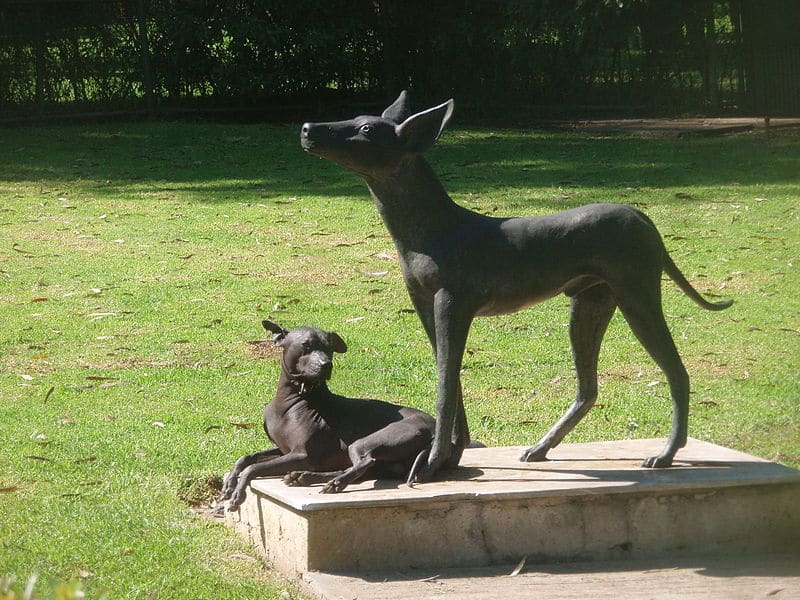
To complete Diego Rivera and Frida Kahlo’s tour, you need to visit Museu Dolores Olmedo, a millionaire, friend of Diego’s, and the person who amassed most of his and her work, on display at the museum which she donated to the people of Mexico.
The museum is housed in a 16th century sprawling hacienda called La Noria, with pretty gardens and peacocks, you can also spot some of the really weird looking precolumbian hairless Xoloitzcuintli dogs.
There are also rooms devoted to pre-Hispanic art, a hobby she shared with Rivera, and Mexican folk art. Beware that the Frida Kahlo collection is often on loan to other institutions so it may not be at the museum when you visit. This is usually indicated on their website. When I visited it was in Budapest.
Tip: Because the museum is far from the Historic Center of Mexico City, it pays to plan well and explore it on a visit to the south including Frida Kahlo’s Museum, the pair’s Casa Studio, Xochimilco, UNAM and Coyoacan.
The museum offers guided visits which need to be prebooked or there is an audio guide to follow. More information here.
Museo Tamayo Arte Contemporaneo

This contemporary art museum located in Chapultepec Forest and founded by muralist Rufino Tamayo is one of the most popular among the artsy crowd of Mexico City.
The building opened in 1981 and was designed as a museum from the start, giving a nod to Mexico City’s pre-Hispanic past through its pyramidal shape.
The museum displays two types of works, modern and contemporary, from internationally renowned artists like Francis Bacon, Joan Miro or Pablo Picasso. Rufino’s work is also on display.
The museum offers guided visits. More information here.
Casa Estudio Luis Barragan

This museum is one of Mexico City’s must see attractions and UNESCO listed but only accessible to those who plan ahead as the house is only opened to the public by appointment in order to preserve its interior just the way the notable architect left it in 1988.
This is the only private house in latin American that is listed as a World Heritage Site thanks to its universal value and uniqueness. Inside you can see some of Barragan’s most famous contributions to architecture, such as the free standing staircase that juts out of the wall like the famous Ikea Billy shelves.
Book ahead here for the one hour guided tour. This is the most expensive of all the things to do in Mexico City costing 400 pesos, almost 10 times the usual ticket price.
Soumaya Museum

I stumbled upon the Soumaya Museum when wondering what to do in Mexico City on a Monday when almost every other museum was closed, but this one was open and free to enter, every day of the year.
These two reasons alone should merit adding Soumaya Museum to your top things to do in Mexico City but that would discredit one of the most interesting attractions in the city, even if it was just because of the value of its art, all owned by a single individual.
This not-for-profit artistic institution founded by wealthy Mexican businessman Carlos Slim, 5th richest man in the world according to Forbes, to showcase his private art collection, is housed in a stunning building by Fernando Romero (his son in law) in consultation with Frank Gehry is made of metal hexagons that seem to be floating in the air.
Inside, there are six floors with art pieces and objects from Mexican and European artists. The collection ranges from coins from the time of New Spain and Mesoamerican objects to the works from famous Impressionist artists like Monet, Degas or Van Gogh, and Surrealist artists like Picasso, Dali and Miro.
Slim is also known for having the largest collection of Rodin’s work outside of France, all of which is on display at the Soumaya.
More information here.
Museo Anahuacalli

This museum founded by Diego Rivera houses his private collection of pre-Hispanic art in an impressive building that was designed by Juan O’Gorman with volcanic rock from the area and inspired by the teocalli, the house of energy in Nahuatl.
The museum is located on volcanic land that was created from the eruption of the Itxel Volcano in 400 AD that the couple bought with the intention of retiring to a farming existence in their ranch. It opened in 1964, after the painter’s death and was finished by Dolores Olmedo, Joan O’Gorman and the painter’s daughter Ruth.
The architecture looks like a pre-Hispanic temple and is worth a visit on its own. Inside, a selection of 2,000 pieces and objects from the 45,000 that make his collection are on display across four floors.
The artist was an obsessive collector, at a time when this was still allowed by Mexican laws, and he amassed an incredible amount of objects from across Mexico’s archeological sites. There is also a room devoted to his works where you can see draft sketches for some of his famous murals.
There is a bus service connecting this museum and the Museum Frida Kahlo on Saturdays and Sundays with a combined ticket for the two. More information here.
Museo del objeto del objeto (Museum of the Purpose of Objects)
With all the serious and history-related things to do in Mexico City, you may need a bit of a break and something easier on the brain, the Museum of the Purpose of the Object is an amalgamation of everyday objects from the last two centuries.
Here you can see banal and almost invisible objects like Coca Cola bottles and their packaging, design and related ads. More information here.
Museo Nacional de las Culturas (National Museum of Cultures)
Visiting Mexico City is like traveling back in time to 1,000 years ago and learning all about the Mesoamerican civilisations.
At the National Museum of Cultures you can complement that with a look at all the other important civilisations that have existed in the last few millennia and also explore an 18th century building that used to be the House of Mint.
Through the various rooms you can learn more about the Egyptians, Mesopotamians, Persians, the Greeks and Romans, and the Chinese among others, all the grand civilizations are represented there.
More information here.
Museo Casa de Leon Trotsky (Leon Trotsky Museum)

Trotsky in Mexico City?
Yes!
The Russian Socialist leader found political asylum in Mexico City in 1937 after being expelled from his country by Stalin in 1929. This museum was created to honor his memory and contains his ashes. It is managed by an organisation that defends the right to asylum.
When he arrived in the city, Trotsky and his wife stayed with Rivera and Kahlo for two years until he bought the house where his museum is now based in Coyoacan. The pair were known socialist supporters, as shown in most of Rivera’s murals’ themes and persuaded the Mexican President to grant him asylum. It is said that Trotsky and Frida were sexually involved despite both being married and this was the reason for the move.
The museum offers guided visits which will take you through a historical trip down memory lane, to the Russian revolution and the rise of Marxism.
You will also be shown to the bullet holes, still preserved, from an assassination attempt by muralist Siqueiros in 1940 when he attacked the house with a machine gun. Trotsky was finally killed under Stalin’s orders by Ramon Mercader in the same year.
More information here.
Museo del tequila y el mezcal (Tequila and Mezcal Museum)

This museum appropriately located on Garibaldi Square, will tell you more about the country’s most famous drink, in case you don’t have the chance to visit real Tequila, in Jalisco.
The museum will also tell you more about the mariachi culture, so that you get prepared for the spectacle that fills the square.
The museum also offers tours of the Historic Center that end at the museum, and guided visits of the museum itself. There is also a traditional cantina and a shop to buy some tequila. The museum visit ends with a tasting.
Tip: The museum closes at 7pm which is later than any other museum so leave it for last. More information here.
Polyforum Cultural Siqueiros

This cultural center part of the World Trade Center Mexico City is decorated with Siqueiros’ decadon mural called La Marcha de la Humanidad (The March of Humanity) which is considered one of the largest in the world and opened in 1960 and was designed for Manuel Suarez Suarez.
The structure is made of several parts, the Universal Forum, the Emerging Art Space, the shop and the Youth Forum. Although the outside murals are what draws most of the visitors, the interior architecture is also quite interesting and worth a visit.
The museum offers guided tours which can be booked online, and on weekends there is a music and light show that plays the artist’s voice and explains the mural.
Former College of San Ildefonso

This 16th century complex used to house the Jesuit Seminary. Today’s Baroque architecture dates from the 18th century when it was rebuilt thanks to the order’s financial resources and the Crown’s wealth.
When the Jesuits were expelled from Mexico in 1767, the building became a military site under various managements until it was converted into a school and then part of the university in 1910.
The building opened as a museum in 1992 with two rooms, one with wall murals and the other where temporary exhibitions are displayed. The building’s amphitheatre is home to Diego Rivera’s La Creacion mural.
Aside from temporary exhibitions, the college is a beautiful structure with a large courtyard filled with trees and worth a visit for the architecture.
Tip: the museum closes at 8pm on Tuesday so it makes for a great place to visit when everything else is closed. More information here.
Explore Chinatown

Before visiting Mexico City I did not know that there was a small but thriving Chinatown at the edge of the Alameda Central and right in front of the Palacio Bellas Artes.
The area is not very large and may as well be the smallest Chinatown in the world, but it is a welcome change from the otherwise Latin themed city. Go under the Chinese arched gate and enter a block of shops and restaurants that will take you back to Asia.
See the beautiful Casa de los azulejos

The colorfully tiled facade of this building is what has made it famous and easily recognizable in the sea of tourist attractions that line this busy street of Mexico City.
La Casa de los Azulejos, the House of Tiles, is a blue tiled corner building that used to be the residence of the Valle de Orizaba Counts. One of their descendants decided to decorate the facade with tiles from Puebla in the 18th century giving it its now famous look.
Inside is one of the branches of Mexico’s Sanborns restaurant, recommended by the Michelin Guide, since 1919. You can stop by for an atmospheric meal and look out for José Clemente Orozco murals and for the tiled fountain.
What makes Casa de los Azulejos so unique is the combination of tiles from Puebla, colonial architecture and Baroque design.
Visit Chapultepec Castle, Latin America’s only castle


Chapultepec Castle sits atop the forest and hill of the same name, tall above the trees and with magnificent 360 degree views over the city. It houses the National Museum of History across its 12 rooms and also showcases the furniture and decoration from the time in the castle’s rooms, left intact.
This unique castle is the only in Latin America of its kind, Mexico City’s most visited landmark and was the historic residence of the Emperor of Habsburg. The name Chapultepec comes from the Nahuatl for grasshopper (chapu – like the chapulines, one of the most unique Mexican foods) and for hill (tepe), translating as the hill of grasshoppers.
It was also one of my most favorite places to visit in Mexico City because it combined history with a dose of royalty, fresh air, rare in a city of 25+ million inhabitants and good views. I ended up spending three hours there instead of the one hour I had allocated, and I had to be kicked out for staying until closing time.

The construction of Chapultepec Castle started in 1783 and was conceived as a vacation residence for the Spanish Viceroy. But the construction was halted in 1785 and the Spanish Crown decided not to resume it and put it up for sale.
As nobody was interested in purchasing it, the representative of the Spanish Crown decided to start auctioning its valuables. The war of independence in 1810 and an earthquake in 1918 left it in ruins.
Through the centuries, its role changed into a military school, until it became the residence of the Emperor Maximilian in 1864. He renovated it to today’s splendor.
When the country became a republic again, Chapultepec Castle was turned into the Presidential Palace, until it was converted into the National History Museum it is today in 1944.
Apart from admiring the architecture, the rooms of the Emperor and subsequent presidents and the National History Museum halls, Chapultepec Castle is also home to several famous murals by O’Gorman, Siqueiros and Clemento Orozco. The large Retablo de la Independencia is incredible and very big.
More information here.
Moctezuma Baths

The Baths of Moctezuma, also known as Pools of Chapultepec, or Albercas de Chapultepec, are part of a network of aqueducts, pools and canals that were built in the 15th century by Moctezuma and other Mexica rulers in Chapultepec hill to supply water to Tenochtitlan.
After the arrival of the Spanish the baths were used for many other reasons and were even the private pools of rulers, heads of state and Hernan Cortes himself. During the time of President Porfirio, the baths and the entire Chapultepec area were remodelled and given the octagonal shape. The baths were originally rectangular.
You can visit the remains of the pools and aqueduct in Chapultepec, entrance is free.
Coyoacan downtown
I talked about Coyoacan before and mentioned that it is where a few of the top things to do in Mexico City are, including Frida Kahlo’s Museum, or Leon Trotsky’s Home.
But the borough south of the city is also a place to come for a stroll, shop and eat at the markets and to explore the city center. Spending a day in Coyoacan is a must on your visit to Mexico City and you should set at least half a day to a day aside for it.
Coyoacan main plaza and coyote fountain
The main square of Coyoacan is the starting point for almost anyone visiting the area. At one end is the Casa de Cores, the Conquistador’s summer house, and at the other the Church of San Juan Bautista.
The square is large and leafy, and it can be split into two gardens: Jardin Hidalgo and Jardin Centenario. The area is filled with large trees that provide shade to the few benches where you can sit and people watch.
Street vendors sell colorful balloons, cotton candy and other toys, and there are traditional musicians at all times of day and week. The square is one of the most peaceful ways to spend half an hour chilling, or enjoying those churros you bought!
In the center of the square there is also a fountain surrounded by coyotes. The word Coyoacan comes from the Nahuatl for “the land of people who own coyotes” and the animal is also included in the shield of the city.
Church of San Juan Bautista

The church and convent were first built in the beginning of the 16th century but renovated and rebuilt several times in the space of the last four centuries. This makes it one of the oldest churches in Mexico City, and the city has many.
When you face the building’s entrance you can see that some part of it is newer than the rest and that the building looks like it has a long history, as it does. Above the entrance door you can read: “No hay nada más aquí que la casa de Dios y la puerta del cielo”, or “There is nothing here other than God and the door to Heaven”.
The church was originally occupied by the Dominiacn order and subsequently by the Franciscan order from the 20th century.
Inside, the church is rather flash, but the paintings and golden decorations are not original but were added during the most recent renovation finished in 1944. The convent’s cloister is a real gem and worth a visit. There you will find a nice garden, look up to the ceiling of the cloister alleys and you will see the original paintings.
Enjoy traditional food, and churros!
Coyoacan is well known for its food as well. There are countless restaurants, bars, snack places and markets to devour all the best Mexican foods.
Some iconic places are the Coyoacan outpost of hip Mercado Roma where you can enjoy a more innovative take on the traditional foods, La Casa de Los Tacos, for variations on the classics and a gallery on the upper floor, or the more formal El Tajin.
Frida Kahlo and Diego Rivera liked to frequent Cantina Guadalupana and for a good dose of snacks, Mercado de Antojitos will let you sample Mexico’s best street food all next to each other, it does not get better than having all the foods under one roof and being able to combine them. Look out for pozole, tacos, gorditas or tostadas and finish the meal with hot cakes (pancakes).
Cineteca Nacional
This movie theatre and foundation is a great place to come watch movies, of which there are many showcased every day. You can check the timetable here. Tickets are only 50 pesos or 30 for those below the age of 25.
The center promotes alternative and indie movies, from local and international teams, and has a lot of documentation about the film industry for research and consultation and a bookstore.
Take the tram
The tram will take you around Coyoacan for about 40min during which you will also get a guided tour of the main sights. As Coyoacan is a pretty quiet part of Mexico City, this makes for a rather leisurely way to explore the area.
Basilica of Our Lady of Guadalupe

This is the second most visited church in the world and the site of a miracle that convinced the indigenous Aztecs to convert to Christiniaty when the Spanish arrived.
The Basilica and Shrine contain the cloak of Saint Juan Diego Cuauhtlatoatzin who is believed to have been the center of a miracle when the Virgin Mary appeared to him.

Teotihuacan

The pyramids of Teotihuacan are Mexico’s most visited site, almost twice as popular as Chichen Itza or Tulum, and an incredible place to see near Mexico City. It is also a UNESCO listed site since 1997.
Teotihuacan means “the place where men become Gods” and it is certainly an impressive sight, even if only 10-20% of it has been excavated.
Teotihuacan is contemporary of Cuicuilco and part of the classical mesoamerican civilisations period which spanned from 2,500 BC to the 200 AC. when Cuicuilco was destroyed in a volcanic eruption, Teotihuacan became the most important urban center in the area.
The city flourished from the 5th century onwards, and this is when the large avenue and the pyramids were built, the houses and complexes and the pyramids that we see today. But the city did not last long and around the 10th century it had been abandoned after fires and battles with other civilisations.
No other group occupied the area which became engulfed in vegetation. Although its existence was known to others, and it became a pilgrimage destination for the Aztecs, it fell into oblivion until the beginning of the 20th century when the Mexican government ordered its excavation and preservation.


This is one of the few and first archeological sites to have been excavated and studied in Mexico, where the vast are still waiting to be discovered.
The site is huge and the main Avenue of the Dead measures 2km long. You can go up the Pyramid of the Sun and about a third up the Pyramid of the Moon. Beware, with the altitude that Mexico City already is at, the climb is not as easy as it looks, so take it easy.
You will also be able to explore the houses where people lived, the altars, the few remaining murals (look out for a tiger!) and the other temples. You should budget for 1,5 to 2h to see it all and climb the pyramid at a leisurely pace.
Teotihuacan is best visited on a guided tour which will take you there (there is no easy public transportation to get there) and will provide you with a brief introduction followed by free time to explore on your own.
I went on this tour which included a pick up from my hotel and was small, (we were 8 guests only). The tour started at Tlatelolco and ended at the Guadalupe Shrine. There was a lunch stop at a local restaurant (200 pesos for buffet or a la carte options).
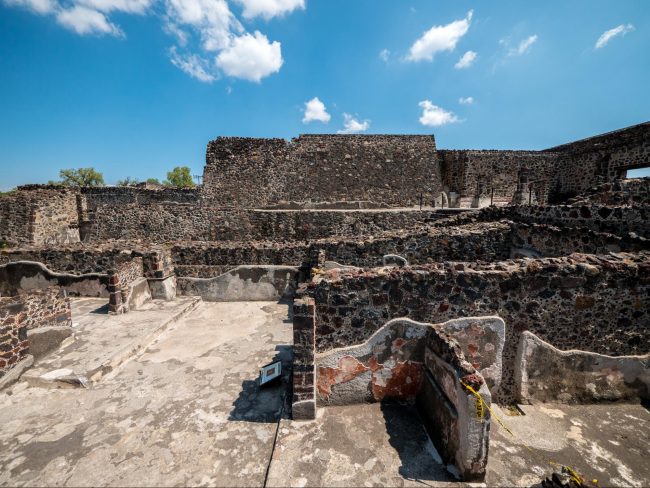

We also visited a souvenir shop where we learned about the many uses of the agave plant and tried some local liquors. We were free to browse the store and purchase, I did buy a bottle of local liquor and would have bought one of the stunning masks. The tour guide, Sandra, was pretty nice and gave us some pulque to try and had some spicy Mexican candy.
Other tours are larger in a big bus and start at a pick up point, but you would probably spend the same on taxis to get to the pick up point and the smaller group meant more time with the guide.
Tip: another great way to see Teotihuacan is at night during one of the light and music shows. This should not replace a day visit, because you can’t climb or really see the pyramids at night, but it is a magical experience.
Xochimilco
This borough 30-45min drive south of Mexico City is one of the few parts of the city that still preserves the lakes and canals that were there before the Spanish arrived and gives an excellent and unique insight into what it is built over (and why it is sinking so much!) so I highly recommend including it in your Mexico City things to do list.
Xochimilco is a UNESCO listed maze of canals, gardens and houses disconnected from the rest of the city other than through some bridges and boats. These pieces of land in between the canals are known as chinampas, and represent the last remaining vestige of a cultivation method that dates from pre-Hispanic times.
The area is known for its fertile soil where locals grow plants and flowers. This is where most of the city’s flowers and vegetables come from and where locals come to buy their plants.
Xochimilco was founded in the 14th century by a Nahuatl tribe who called it Xochimilco, meaning “the land full of flowers”, and the name is still representative of what the area is today.
One of the most popular things to do in Xochimilco is taking a ride on one of the hyper colorful trajineras, the wooden flat boats that explore the canals. These boats are named after women and used to be decorated with fresh flowers, however they are now painted instead.
Local men will still ask the owner of a trajinera to decorate it with flowers and the name of their lover for special occasions like weddings, proposals, or Quinceanera parties.
The canals are filled with all sorts of street sellers who take their goods from boat to boat. There are even floating restaurants that will hook their boats to the trajinera and cook your lunch or dinner on the spot.

Mariachi bands and groups of Norteno bands also fill the canals and offer their services. You can hire them by the hour or by song, and they will join your boat for as long as their performance lasts, then head back to theirs.
To join a journey around the canals on a trajinera, you can simply show up at one of the piers and book one for an hour or more with friends, each trajinera can accommodate up to 20 people comfortably.
It is common to see families and groups of friends enjoying their lunch there, sometimes with their own music, food and drinks which they bring from home. When I was there, being the end of the school term, the canals were filled with students celebrating the beginning of Easter.
Alternatively, there are also group boats that you can join if you are a solo traveler, but those are only available on the weekends, you would just pay a ticket and join the rest of the passengers.

I visited Xochimilco as part of this tour which also stopped at Coyoacan and at the Frida Kahlo Museum in the morning. Joining a tour is highly recommended because on weekdays it is expensive to go alone or with just another traveler (you would have to book a whole trajinera) and not really very atmospheric, to visit on your own. You would also be less likely to enjoy mariachi groups since they would favor the busier boats.
People watch at the Zocalo

The Zocalo, officially known as PLaza de la Constitucion but referred to as Zocalo by pretty much every local, is the heart of the city and one of the largest squares in the world.
The Zocalo was first built by Cortes when he destroyed the Templo Mayor and used the rocks to pave the square and build the cathedral. The area evolved and had several uses until it became what it is today: the center of power.
Strolling around the Zocalo is one of the most fascinating things to do in Mexico City. This is also where the Palacio Nacional, the stunning (but sinking) Catedral de Mexico and the various government offices are located.
In the early hours of the day, as I discovered, the square is the place to come demonstrate and protest about anything. Today is a missing group of children, tomorrow the taxes of some goods, the following day is the political corruption.
And Mexico City citizens are efficient, the demonstrations happen at the wee hours before they head to work and even before the sun has come up.

The Zocalo is a great place to people watch. There are often exhibitions or other artististic displays and the areas around the cathedral are often filled with Aztec dancers singing and dancing around smoke. Look out for the character dressed like death.
The outfits of the dancers and their towering feathers coupled with the shell bracelets and the elaborate and colorful costumes are stunning.
Musicians fill the area with their music and street vendors will pop up as the evening approaches to sell traditional antojitos.
In the center of the square there was supposed to be a tall statue to commemorate the Mexican Independence but the statue was never erected and its base gave name to the square. Today, a Mexican flag stands tall in lieu of the statue. If you are at the square at 8am or 6pm you can see the daily flag raising and lowering ceremony by the army.
Mexico City Cathedral
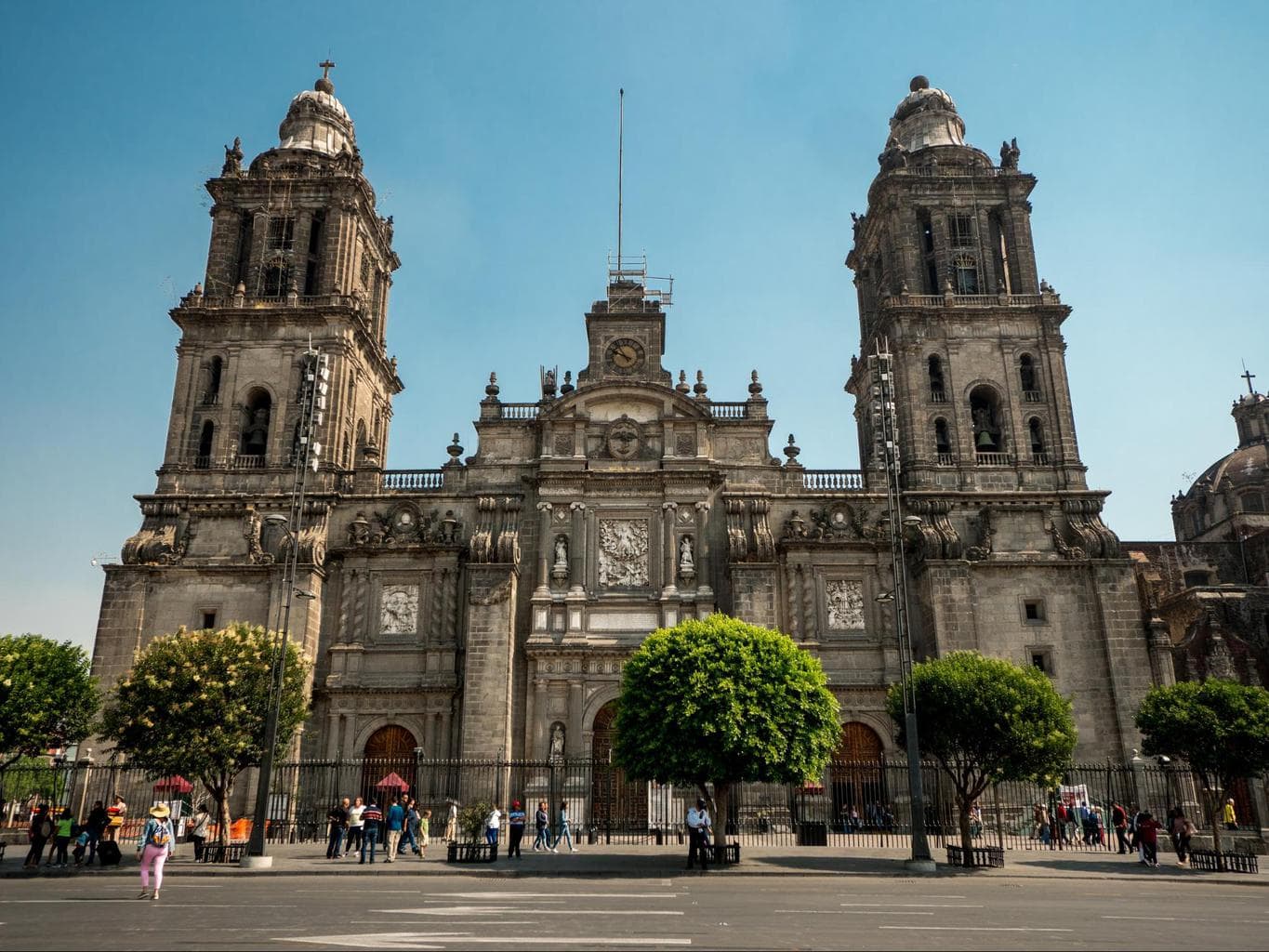
The city’s most prominent of the many churches is also one of the oldest and the one most suffering from the sinking problems of Mexico City. Today, it is also Latinamerica’s largest cathedral and a sight to behold.
Mexico City Cathedral was started in 1524 by Hernan Cortes who wanted it to be located on top of the Temple of Quetzalcóatl, known as Templo Mayor as well, and the most important Mexico City attraction. It was also built with the stones from the temple, after it was triumphantly destroyed. The building was consecrated as a cathedral in 1547.
The original construction was demolished in favor of today’s about 40 years later and the new sacristy was completed in 1623. Mass service has been offered at the cathedral since 1626 however, it was not inaugurated until 1667.
The structure is massive and in the shape of a cross. The facade and bell towers that we see today date from the 19th century and its prominent chair and furniture came from the Spanish colonies in Asia, the Philippines and Macau. This development of the cathedral, which spans 3 centuries, gives it its rich artistic value, with various styles from the 16th to the 19th century.

Inside, the cathedral is filled with incredibly intricate altars and chapels, many of which are decorated in gold. It is said that one of the 30 bell towers is cursed. The bell once fell over a young man killing him instantly and since then the bell has a red cross on it.
The cathedral is home to more than 100 catholic relics such as a piece of the cross which is kept in a hidden room.
The sinking problem of the many buildings in Mexico City was threatening the cathedral for many years by the rehabilitation efforts carried out over a couple of decades managed to correct the incline of the building from 2,4m to just 1m. If you pay attention you will be able to notice this.
Tip: the cathedral is open to the public daily but during mass times you will not be able to enter the majority of the building. Make sure to come between 2,30 and 4,30pm when there is no mass and you have a better chance of seeing all the naves.
The cathedral also offers guided tours of the crypt and night tours, and you can climb up to the bell towers twice a day every day. Tickets can be purchased from the cathedral, inside to the right there is a small counter selling souvenirs that also sells the tickets.
More information here.
Templo Mayor
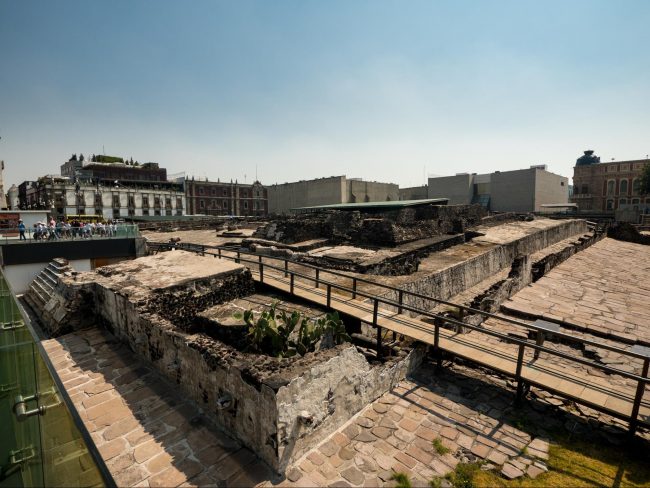
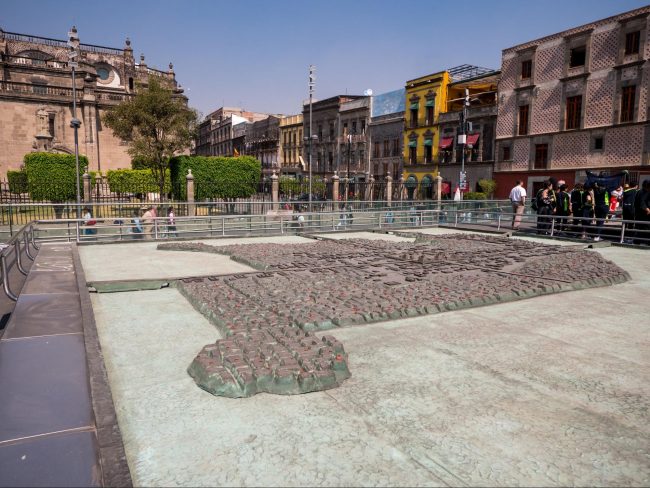
Temple Mayor is the Spanish name used to refer to the main temple in the ancient Mexica city of Tenochtitlan, which used to be where Mexico City is today but was destroyed and conquered by the Spanish in 1521.
The remains of the temple and a museum are located right by the Mexico City Cathedral, which was built with its stones, and is one of the most fascinating places to visit in Mexico City.
For centuries after the conquest, the temple was buried under the new city and forgotten. It was only at the end of the 19th century that its remains were rediscovered but the area was not fully excavated until the end of the 1970s. It is surprising to think that such an incredible tourist attraction was not there four decades ago.


Tenochtitlan was founded in the 14th century on an island on Lake Texcoco in an area where the Aztecs, known as Mexica, had found the eagle resting on a cactus, an indication that they should build their city there. This symbol is still represented on Mexico’s bills and coins and used as the emblem of the city.
The Aztecs used to build temples progressively, each ruler building on top of the previous and making the resulting temple taller and larger. The Templo Mayor has seven layers and can all be observed. At the top, the temple measured 30m and was made of a double pyramid dedicated to the two main Gods: Tlaloc, the God of Rain and Coatepec, the Serpent God.
The site can be partly seen from outside, without having to pay a ticket, as the ruins are right in the open in Mexico City’s historic center, however, the museum and about half of the ruins can only be appreciated from up close, and for that you need a ticket to get in and stroll the elevated walkways.

To me, this was a morning well spent for a few pesos and one of Mexico City’s must see attractions. Budget for at least 2-3 hours as the museum is quite large and has a lot of the relics and finds from the excavation.
Closer to the museum, under a cover, you will also be able to spot the wall covered with skulls, an iconic discovery. There are also some portions of the wall where the former murals are still visible.
Palacio Nacional
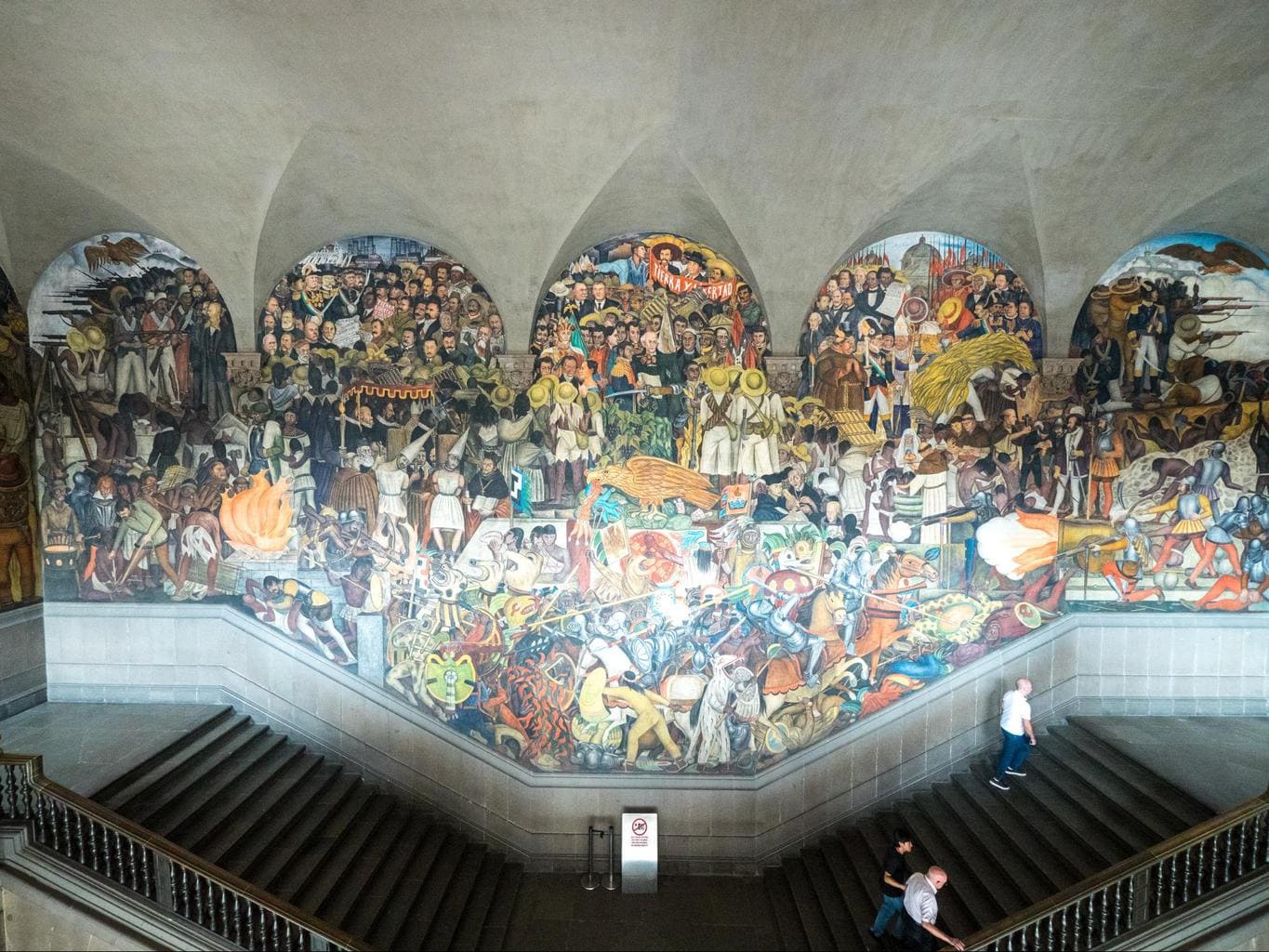
Flanking the Zocalo, at the heart of the Historic Center of Mexico City, is one of the most popular of Mexico City’s attractions, the Palacio Nacional, the site of the country’s government.
This large complex houses the Treasury’s offices and is home to some of Rivera’s most important murals, in particular the large three-part mural that surrounds the stairs to the first floor called History of Mexico.
Guides are often available at the entrance for a one hour tour of the building and the murals. I paid 400 pesos for the one hour private tour and it was well worth it. Without a guide, you would miss 99% of the meaning of the murals.
Tip: You will not be allowed in without a picture ID that you have to leave at the entrance in exchange for a pass. The only way to circumvent this rule is by hiring a private guide who will respond for you. Entrance is otherwise free.
Tlatelolco

Coming from the Nahuatl for sandy place or place of the round platform, Tlatelolco is an archeological site in the north of Mexico City that allows the visitor to understand the origins of the city, the pre-Hispanic political climate in Mesoamerica and the impact of the arrival of the Spanish colonizers.
The site is not very large and can be seen from outside, although entrance is free of charge so I would recommend that you explore this Mexico City attractions by giving it at least an hour of your time.
The city was founded in 1337, just a few years after Tenochtitlan, by the same Mexica people, or Aztecs, and it is one of the oldest in the city. The excavations started in 1944 and uncovered the structures that we see today which are surrounded by elevated boardwalks you can walk on. Until then, Tlatelolco had been buried and forgotten.
The archeological site is made of a small museum housed at the entrance to the site, the Museum of Tecpan, the church of Santiago de Tlatelolco, the Caja de Agua water deposit and the convent and Imperial College of the Holy Cross of Santiago de Tlatelolco.


The museums and the church are open to the public daily but the water deposit can only be visited through a previously agreed appointment.
Start the visit at the museum and continue along the boardwalk. There are signs that tell more of each of the pyramids and structures and the itinerary will take you to the church and convent of Santiago Tlatelolco and the Museum of Tecpan.
One of the interesting parts of the visit is also the stop at the Caja de Agua, the large water deposit that was built to keep water and supply it to the city and whose walls are decorated with murals. It is unclear when it was built but it is thought to have been after the arrival of the Spanish.
The church was built with rocks from the Templo Mayor at the request of Hernan Cortes in 1527 and the adjacent college was added with the objective of educating the indigenous population. The college was managed by the Franciscan order along with the church which was renovated and expanded to today’s size in 1610.
The college and the church were abandoned and looted in the 19th century when the area was hit by disease and the church was eventually transformed into a military college during the Mexican revolution.
Cuicuilco
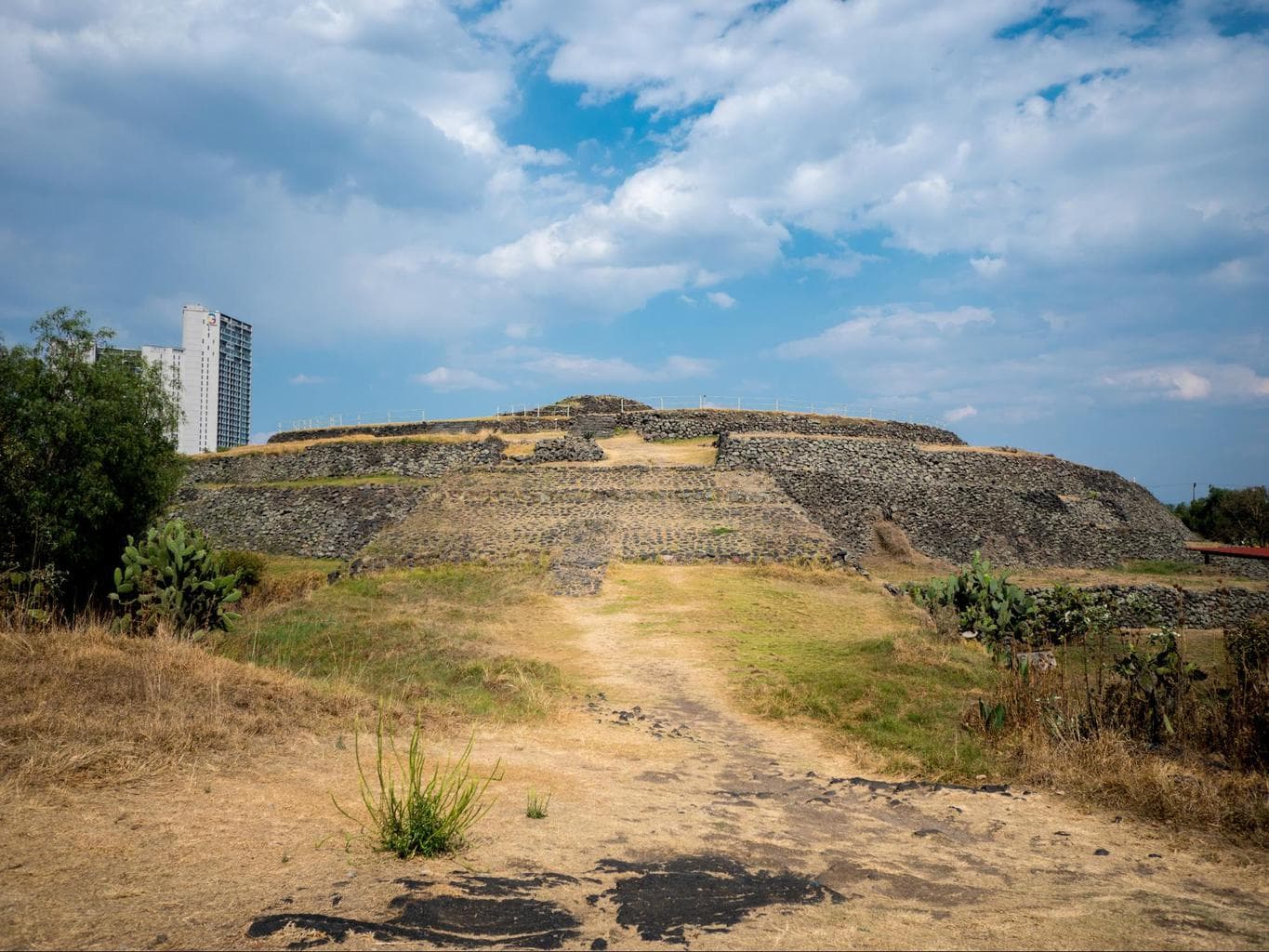
A visit to the archeological site of Cuicuilco is one of the most interesting and unique things to do in Mexico City, for one, I was alone throughout my visit and did not see another tourist around. There were only two other people in the park area and they were a local couple laying on the grass enjoying the sunshine.
This ancient Mesoamerican site is notable because of its monumental round pyramids which were one of the first ones to be built and inspired later Mayan and Aztec architecture. The site dates from the 500 BC and is one of the least well preserved in the city, albeit also the oldest.
Cuicuilco was one of the first large Mesoamerican cities and it is believed to have been home to 20,000 people at the time when the cultures grew beyond small villages. What can be visited today is part of an extensive park where the remains were excavated.
The largest structure in Cuicuilco is a pyramid measuring 135m in diameter and made of four levels topped by an altar. You can climb up to the top. The pyramid was built with volcanic rock typical of the area and is today covered in grass.

Although Cuicuilco had circular pyramids, quite unique to this site, it is thought to have marked the beginning of the monumental pyramidal architecture that is later seen in Tenochtitlan or Teotihuacan. The city disappeared under lava from the Xitli volcano in around the 2nd century BC and finally abandoned after a second eruption in the 1st century BC.
Because of the several meters of lava flow covering the site, excavations only started in the 1920s. Compared to Tenochtitlan and Teotihuacan, important archeological sites in the area, Cuicuilco is not as impressive nor is it as well preserved. The lack of a museum nearby that provides more details makes the visit less thorough but still a great place to visit in Mexico City.
The area is covered in green grass and trees that provide shade and while there is not a lot in the way of signage or explanation, Cuicuilco makes for a good picnic spot, with some benches and fluffy grass on which to rest. There are also a few native Mexican plants and bushes, and several kinds of cactus.
The site is located south of Mexico City, about half an hour’s drive from the historic Center, and entrance is free of charge. You can find more information here.
Street art
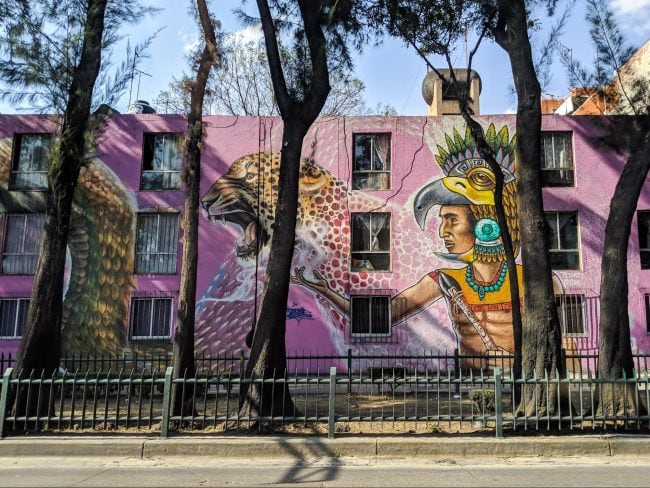

Mexico City has a lot of street art and you will see examples of it across the city. Building facades and even entire streets are covered in colorful murals depicting various topics.
One of the most beautiful streets to admire is the one along Biblioteca Vasconcelos which is entirely covered with famous Mexican characters in brightly painted colors.
Biblioteca Vasconcelos

This public library with free access for everyone is an incredible feat of design and worthy of inclusion in the list of the best things to do in Mexico City.
As you approach the building, you cannot imagine what lays inside. Outside, the structure is a simple concrete vertical building, inside, it houses an expansive, incredibly intricate but functional library made of interlaced and staggered levels in an open plan design.
Outside, the library is surrounded by a garden that is filled with native plants. There is a small cafe as well and a sense of detachment from the ongoing traffic emanating from the major train station outside.
The library is open to anyone and gives access to 600,000 books and 400 computers with internet access.
More information here.
Angel of Independence

This famous gold covered bronze statue of an angel in Mexico City is usually referred to as El Angel by the local chilangos but is officially called Monumento a la Independencia.
The monument is located in Mexico City’s most famous avenue, Paseo de la Reforma, and commemorates the independence of Mexico from Spain with an angel with wings.
It was built during the time of Porfirio between 1902 and 1910, and inaugurated on the 100th anniversary. However, today’s angel is from 1958 because the original collapsed and broke during the 1957 earthquake.
The base of the monument is square with representations of War, Peace, Law and Justice on each of the four faces as well as some statues of famous heroes such as Morelos.
You can observe the statue from outside, and you will surely drive past in on your visit to Mexico City, or you can also climb up the 200 stairs to the top view point which is open from 10am to 4,30pm with guided tours on weekends from 10 to 1pm every hour.
To book your tour or your 15 min slot you need to go in person and with your passport to the Patrimonio Cultural de la Delegación Cuauhtémoc and fill in an application form. If you are going with a group only one person needs to go with the details of the entire group, a maximum of 6 people are allowed at a time. You will be given availability options and you can pick whichever suits you. The guided tours are free of charge.
See the metro art
One of the best things to do in Mexico City, as mentioned before, is going out hunting for street art. But perhaps the most unexpected of the street canvases for local artists is the metro.
Some of the city’s metro stations have been covered in murals from the famous Mexican muralists, others have small archeological sites or even exhibitions, Mexico City’s metro is a thriving place filled with artistic expressions of all kinds.
Here are some of the notable stations that are Mexico City attractions in themselves.
Under the Zocalo, the station of the same name has scale reproductions of the square, the cathedral and the Templo Mayor.
For book lovers, the stretch between Zocalo and Pino Suarez is filled with books in what is called Un Paseo Por Los Libros, literally translated as a “stroll along the books”, and you can buy your next read for the metro journey there.
Perhaps the most famous of the mural stations is Tacubaya. Located near Chapultepec Castle and Forest, the station is decorated with the works of Guillermo Cenicero. They sure are a reason to go down to the city’s underground arteries.
Division del Norte station has karaoke booths where you can release some tension by singing to your heart’s content. Polanco is also musically themed, with stairs painted like a piano.
If you don’t have time to go see a Lucha Libre fight, the station of Gerrero is like a small museum with costumes and murals dedicated to this famous Mexican sport/entertainment.
Cafebreria El Pendulo
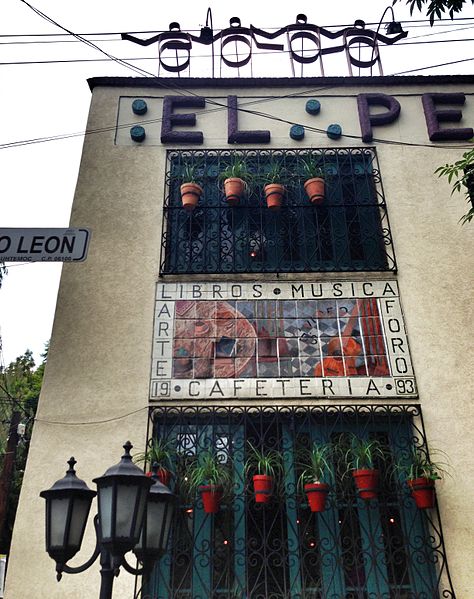
This coffeeshop cum bookstore is precisely that, a merge between a book emporium and a coffee lovers paradise that has also evolved to include other artistic expressions across 6 branches and one bar in Mexico City.
El Pendulo is a bright space with background music and sofas to sink into and read a book. Because it stays open until late (midnight on weekends), this is one of the best things to do in Mexico City after all the museums and other tourist attractions close.
The menu is expansive, offering everything from breakfast to dinner or cocktails and everything in between, and the space is inviting, open plan and laid back.
More information here.
Monument to the Revolution

Monumento a la Revolucion is another of Mexico City’s main attractions and, like Angel de la Independencia, difficult to miss as you are exploring the city.
Located on Plaza de la Republica, next to the National Museum of the Revolution, the monument commemorates the Mexican Revolution and was originally intended to be the Legislative Palace.
Porfiorio launched a public tender for the construction but nobody won it. After many scandals and the fall of his regime, the building’s construction was interrupted by the Revolution.
After the war, the building was abandoned only to be revived by the original architect who came back to Mexico in the hopes of finishing his project. He then proposed a monument to national heroes instead, which was accepted by the president at that time. But when he was assassinated, the construction was abandoned once again and the structure used to build the railways.
Finally, in 1933, architect Caros Obregon suggested the remaining steel parts of the building that were left intact be transformed into a monument to the Revolution, and that was the idea that prevailed.
The monument includes a mausoleum where the remains of national heroes are interred. The Museo Nacional de la Revolución is located on the basement of the monument and has a section that explains more about the monument’s history.
More information here.
Go shopping at the best markets
One of the best things to do in Mexico City is visiting a market, either to buy things (souvenirs, fresh fruit, snacks, flowers) or to simply admire the perfectly stacked produce.
The city has a lot of markets, some are specialised, some are all encompassing, but they will all stimulate every one of your senses.
You can explore the markets on your own, like I did, but I wish I had gone on a tour. Sadly, they were not available when I wanted to book, but here are the two I wanted to join.
This tour is a morning visit to three markets, among which the famous Sonora Market, and an afternoon at Teotihuacan, which makes a fantastic combo. This one has the same but also, ends with a dinner at a local family.
Mercado de la Ciudadela

This is the market to come to buy souvenirs and handicrafts.
Located east of Roma since 1965, Mercado de la Ciudadela is an austere, yellow concrete wall, semi-open air market specialising in souvenirs and other traditional, handmade Mexican objects from all across the country.
Ciudadela was created in preparation for the 1968 Olympic Games which took place in the city, as a way to showcase Mexican handicrafts to international and local visitors.
The structure was originally designed to accommodate the factory of the sandals company owned by the Spanish Monarchy and built at the end of the 18th century and beginning of the 19th, during Mexico’s independence years.
Eventually, the building was transformed into a prison to hold the rebels and it remained under military control until the 1940s when it became a library.

Even if you are not interested in buying anything, La Ciudadela is a great place to visit in Mexico City just because of how colorful it is and because you can shop for anything from anywhere in Mexico without having to visit each place separately.
Here you can buy atrapasuenos (dream catchers), the feathery hanging objects that are said to capture your dreams, textiles and clothing, including thick traditional Mayan blankets and tops, bags, wallets and other accessories, luchador masks, and Day of the Dead painted skulls. There are also clay handicrafts such as bowls, cups and vases and leather objects such as boots of belts.
More information here.
Mercado de Sonora

Mercado de Sonora is the place to visit in Mexico City to fulfil all your esoteric and mystical needs, maybe even the ones you didn’t know you had.
Across its 11 alleys, the market sells herbs, amulets, tarot cards, medicinal solutions for all needs and from all over Mexico, and all sorts of witchcraft objects to put together your own potion.
There are also other more earthly things like pinatas and children’s customs, as well as toys, and there is a rather large section with live animals, unclear if those are also part of the witchcraft tribulations.
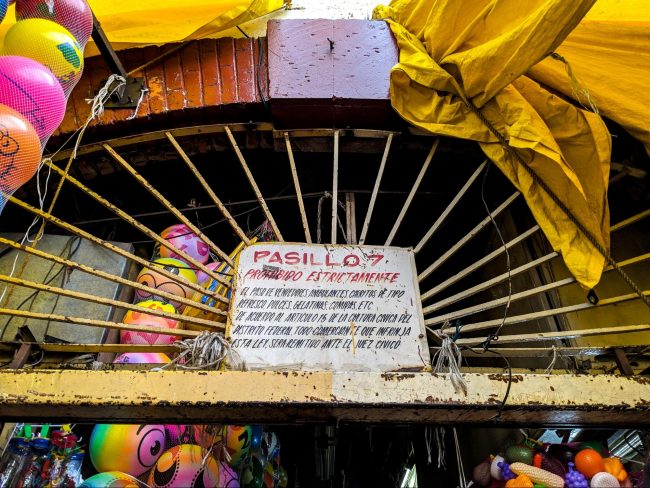

Wandering the narrow lanes of the yellow indoor market is a mysterious affair. Children look for their favorite Spiderman outfit among almost real-size pinatas of the same, while around the corner are glass clairvoyant crystal balls, tarot cards with death images, and several different kinds of godly statues to any cult.
The herb section is more innocuous, with a wide array of herbs from all around Mexico and consultants ready to give advice on what you need to get and in what quantity to cure your ailment, whatever that is.
More information here.
Mercado de la Merced

Across the road from Mercado de Sonora is Mercado de la Merced, a sprawling indoor and outdoor market selling all kinds of fresh fruits and vegetables, meats and fish across several dozen streets in the southeastern part of the city. This is the largest in Mexico City so if you only visit one market, make it this one.
I love markets and this one does not disappoint. Rows and rows of stalls inside the many buildings explode onto the street, with rows of neatly piled corn cobs or the ripest avocados. This is where you can get up and close with the dozens of chilli types there are in Mexico. green, red, big, small, every kind is for sale.
At La Merced you can find pretty much any Mexican food on sale and this is a great place to see how all the ingredients in the famous Mexican dishes look like. You can also sample quite a few of them from the street stalls selling snacks, ambulant vendors also peddle their goods.
Look out for pads of nopal, ready to be eaten, and the staff preparing them with knives and gloves, scraping their spikes. You can also find seasonal fruits and chat to the stall owners about their origin, I bet you have never seen many of them.
Dehydrated mole is also for sale, where you only need to add water to get the paste ready. There is also a large sweets section with all manners of candy and the like to satisfy all your childhood needs and stalls selling insects.
This tianguis, the original Nahuatl word for market, is split into seven sections. It is a fantastic place but it is crowded and also not one of the safest so it is important to pay attention to your belongings.
One of the best ways to explore the market is by taking a food tour so you can see where all the ingredients come from. This 3h tour takes you around the city to taste some of the best foods.
Mercado Roma
More of a modern food market rather than a traditional fruit and vegetable one, Mercado Roma is located in the neighbourhood of the same name and it opened in 2014 to much opposition from the local community who resisted the opening of a gourmet market that would accelerate the area’s gentrification.
If, like me, you are wondering what to do in Mexico City when all the museums and other tourist attractions close, Mercado Roma is a good alternative. While the stalls selling fresh produce will close, the market’s focused on cooked and prepared food keeps it alive with the after-work crowd.
The market combines smaller producers with up-and-coming chefs, organic products with unique cuisine and serves innovative takes on traditional Mexican food.
More information here.
Alameda Central

This rectangular leafy park right by the Palacio Bellas Arte is a busy spot in the city for families and friends to come take a break and is the first public park in the Americas, opening in 1592.
In springtime, when the jacarandas are in bloom, the park is stunning. However, it receives its name from the type of trees, alamos, or poplar trees.
Through the years, the Alameda has evolved, expanded and been beautified with statues, fountains and more trees. It has been the historical place for celebrations and other remarkable events.
Today, contrary to other really crowded parts of the city, the Alameda Central is clean of bikes and skates and dogs are not allowed. Street sellers are also forbidden since the park was renovated in 2012.
Plaza Garibaldi
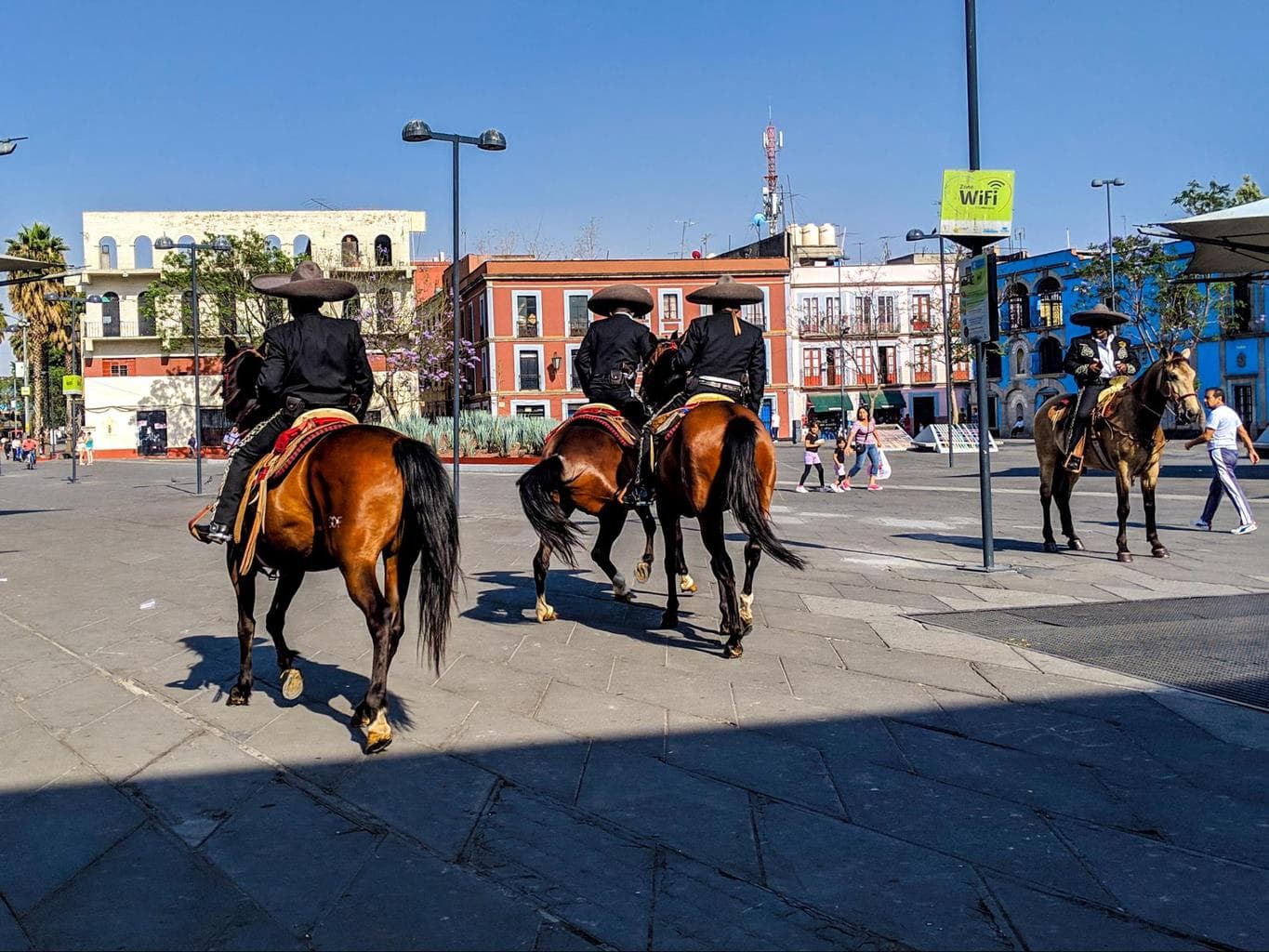
This square near the historic center of Mexico City is where mariachi bands come to perform in search of potential clients since the 1920s. Come night, the area is alive with music, horses and party, during the day it is a bit quieter.
Mariachis are originally from the state of Jalisco, especially of Guadalajara, the country’s second largest city and the home of mariachi culture, listed by UNESCO as an “intangible cultural heritage in 2011”. There, mariachi music is such an important part of life that booking the right band can be the number one priority at any local celebration.
My friend Marisa is from Guadalajara and when she got engaged, the very first thing she did was book the mariachi band for her wedding, a year ahead, before even getting the church or the restaurant. This is how important mariachi music is to the locals.
Plaza Garibaldi is the place to come to spot out the best bands for your private event, or just to enjoy the music for an evening as it is not so commonly available in bars or clubs.
If you just want to have your own personal concert, pick a band and simply hire them per song or by the hour. Price is negotiated on the spot with each band. Some mariachi bands are made of just 3-4 player whereas the larger ones can have 20+, obviously size matters and the larger the band the more expensive the price.

In the restaurants and bars around the square you will see couples being serenaded, usually the guys paying for love songs to be sung for their girlfriends.
You are welcome to request them to play any song, requests are commonplace, and remember that mariachi bands play a wide range of songs and there aren’t that many exclusively mariachi songs, but rather Latin ones.
For some really famous mariachi songs, try El Rey, Cielito Lindo, La Malaguena, Si Nos Dejan, El Mariachi loco, Mexico Lindo y Querido, Volver Volder, Guadalajara or Guantanamera. I am sure you will have heard all of these before. You are invited to sing along and to dance too.
Garibaldi Square is surrounded by some agave plants, to illustrate Jalisco’s tequila tradition, and by the Tequila and Mezcal Museum which is also on site. Some of the bars around are pulquerias, and will serve the infamous pulque drink, this is a great chance to try it.
Aside from mariachi bands, it is not rare to see horse shows by charros (horsemen), another tradition from Jalisco (also part of my friend’s wedding program), where the horses perform tricks or even dance to the music. These are stunning animals.
Leading up to the square, on one end, is a walk of fame with statues of all the important charro and mariachi historical characters.
Visiting Garibaldi Square can be a bit daunting to foreigners as it all happens based on known traditions. Also, at night, the square can become rowdy and dangerous. The best way to learn about mariachi music and enjoy the culture is by joining a tour.
This tour focuses only on Garibaldi Square and a mariachi show. Or make it an all-out Mexican entertainment extravaganza by joining a tour which combines Lucha Libre and Plaza Garibaldi, lucha libre and mariachis.
Palacio Postal

This stunning building is a mere post office but worth a stop even if you don’t have a package or letter to send.
El Palacio Postal was designed by Adamo Boari and Gonzalo Garita between 1902 and 1907 as a post office at the request of President Porfirio. The architects came up with an elegant construction decorated with ornamental statues covered in marble and gold.
As you go inside, you can be wowed by the grand Mexican marble stairs, the bronze statues from Florence or the antique clock that was manufactured in Germany. No expense was spared to make this one of the most beautiful places to visit in Mexico City.
Apart from the building’s facade and ground level, which is open during normal business hours, the upper floors house a permanent exhibition showcasing postal culture, as well as filatelic objects.
More information here.
Torre Latinoamericana
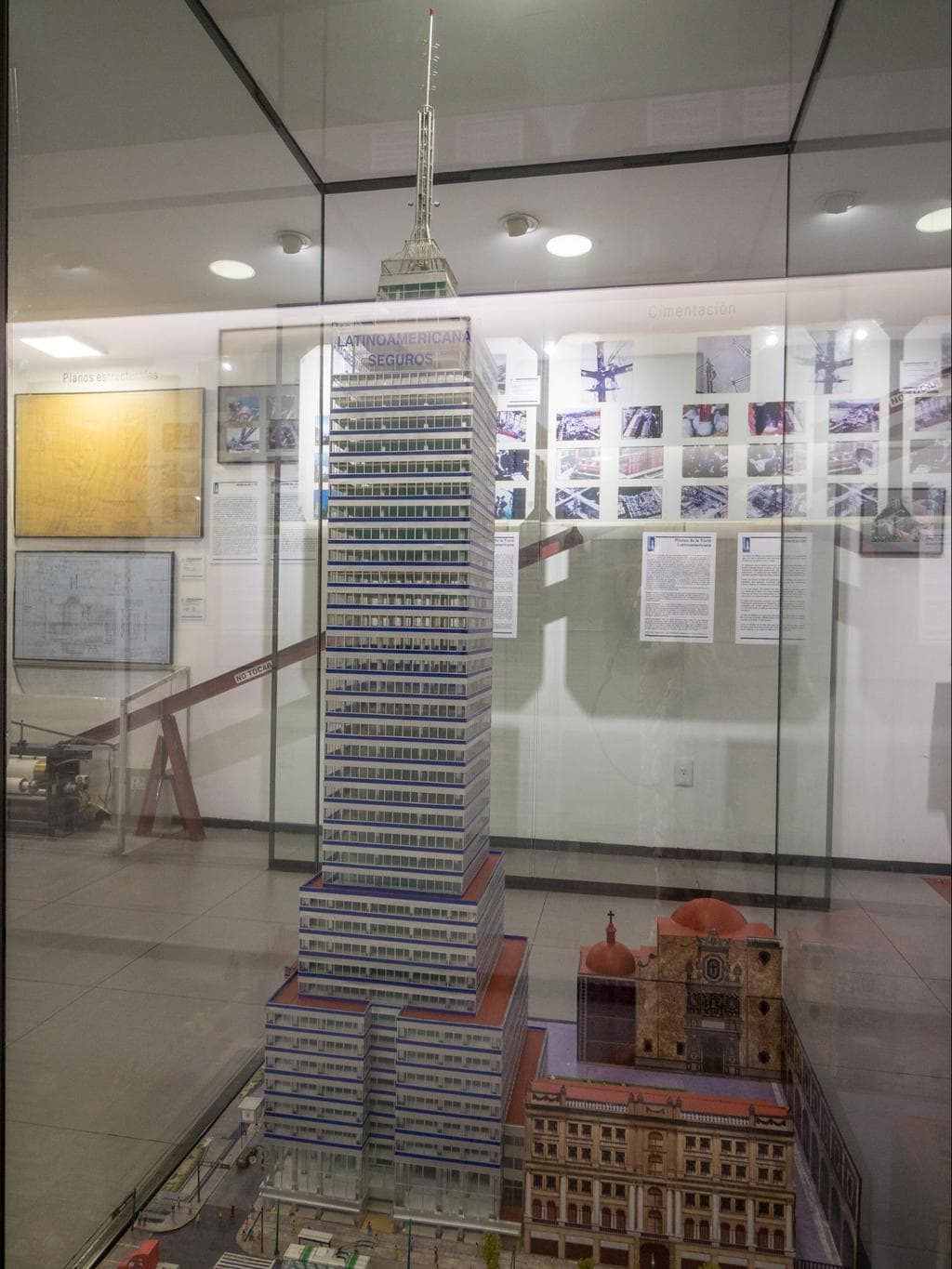
This skyscraper near the Palacio Bellas Artes was the tallest building in the city for the 20 years after its construction and also the tallest in the world outside the US. Today, it is one of the most popular Mexico City attractions not only because of the tower itself but also because of the view it affords.
Torre Latinoamericana, also known as Torre Latino, opened as the first and tallest glass building in the world in 1956 and is notable because of its location, right in the middle of one of the most earthquake-stricken cities in the world. When it was inaugurated, it served as an example for other towers built in places prone to earthquakes such as Taipei.
Torre Latinoamerican is located where the Mexica ruler Moctezuma II had his animal house and there are exhibits that talk about that in the tower’s museum. Talking of which, the two museums that are housed in the Torre Latinoamericana are some of the most interesting places to visit in Mexico City.

The tower was built as the headquarters of La Latinoamericana Seguros, S.A. an insurance company, hence the name. From the floor to the top of the antenna, it measures 181 meters.
When visiting Torre Latinoamerican your ticket will also give you access to the two museums, the Museum of the Tower and the city through the centuries and the Museo del Bicentenario, which commemorates the 200 years since Mexico’s independence from Spain.
The museum of the tower is a good place to learn more about how this masterpiece of engineering was made in a way that it would comfortably and safely survive earthquakes of magnitudes above 8 such as the ones Mexico City has suffered in recent years.
The Museum of the Bicentenarian focuses on the elements of Mexico’s independence related to Francisco Madero with photos, documents and objects that tell more about.

The visit starts with the two museums then climbs up the stairs all the way through cafeterias and souvenir shops until you reach the rooftop Mirador Latino, from where you can have a nice view over the city, La Alameda and the Palacio Bellas Artes.
Visiting Torre Latinoamericana is one of the best things to do in Mexico City at night or even after 5pm when museums and other places of interest close. The tower is open until 10pm and is great at sunset or after dark for a good perspective over the city.
More information about visiting the tower here.
Enjoy the local food
You cannot visit Mexico City without indulging in a variety of street foods or restaurant meals. From the simple tacos from street vendors to the complex molecular cuisine, Mexico City delights, surprises and satisfied the palate of those who give themselves to the city’s fabulous cuisine.
Don’t forget to read all about Mexican food in my dedicated article but if you are in Mexico City, here are some great places to get you started.
Enjoy street tacos
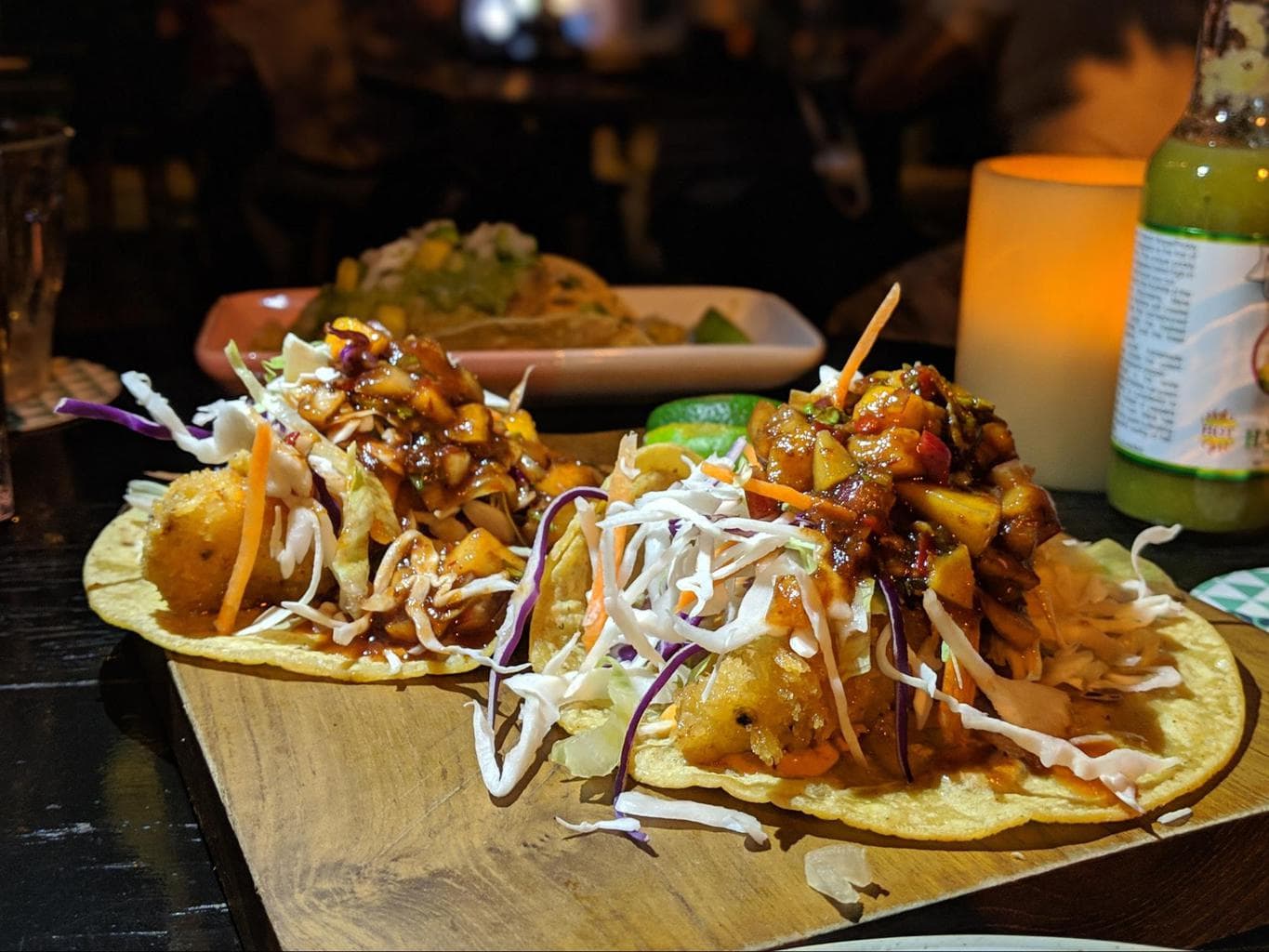
Tacos are one of Mexico’s most famous foods and you cannot spend any time in the country without indulging in them at all times of day and night. Tacos are served as street snacks, they are starters, they are appetizers, they are snacks, they are social foods you eat when sharing a table with others, and Mexicans practically make a taco of anything, effortlessly placing food over a tortilla then eating it as if it was the most natural gesture.
One of the best places to try all kinds of tacos is Tacos Callejeros. Not because they are the best, I would never dare to pretend I have any authority on the matter, but because there is a huge variety to choose from, there are tortillas made with different kinds of corn (blue as well), and because they have a wide range of toppings. So you can basically build your own taco and try all the ingredients in a casual and relaxed environment.
Tacos Callejeros is located near the cathedral too, so it makes for a good stop when you are exploring the Centro Historico and are getting hungry. Do not leave without trying the tostadas as well, and the taco de carnita. They also have a long list of aguas frescas (watered down juices) to accompany the tacos.
Dip some churros

Churros are originally a Spanish sweet snack that was brought to Mexico but they have taken them to the next level by filling them with cream, cajeta (a sort of dulce de leche/caramel), chocolate or Nutella.
The most famous churros place in Mexico City is Churreria El Moro, located in the Zona Rosa and always popular with locals and visitors. Come enjoy them onsite or for take away, while you people watch in this buzzing part of the city.
Deconstructed Mexican cuisine
There are a few well-known fine dining restaurants in Mexico City but the undisputed no. 1 is Pujol. Dining at Pujol is going through a molecular cuisine experience where you can savor traditional Mexican dishes that have been deconstructed or reinvented.
Pujol ranks in all the annual lists of best restaurants and getting a table is tough but not impossible, it only requires proper planning. Book about 3 months ahead and you are likely to get a table.
Eat all the pastries
Mexicans like sweets, despite the fact that the country does not have a long list of desserts. Pastries and sweet snacks, like churros, are well loved and one of the most iconic bakeries in Mexico City pays tribute to this love for sweetness with a huge range of pastries and sweet breads displayed in large trays that disappear under the constant traffic of customers.
Pasteleria La Ideal opened in 1927 and now has three branches across the city. Entering this sweet emporium is like walking into a child’s dream. All the pastries and breads are supersized and deciding what to buy is a feat. I spent 15min just looking around trying to make up my mind and ended up buying three pastries because I couldn’t decide.
La Ideal also sells cakes and has a huge range of cookies and biscuits. The amount of customers passing through the branch in the historic center is such that there are several counters packing your goods while you make payment. The store knows how to make the process efficient and fast.
More information here.
UNAM murals and mosaics
The mural on the walls of the Central Library in the Universidad Autonoma de Mexico in Coyoacan is some of the most impressive work done by one of the country’s most famous muralist, Juan O’Gorman.
The iconic building in the university campus south of the city is listed as a UNESCO heritage building and a must-see attraction in Mexico City, worth the trip down south.
The library building is entirely covered in murals on its four facades. These murals have themes and are also aimed at protecting the books inside by providing a shield from the sun. As with the rest of murals across Mexico City, they were intended to tell the story of Mexico to the masses through graphical representations in popular buildings.
O’Gorman insisted that he wanted to create those in the hopes that the library’s 4,000 square meter facade would tell the country’s history and struggle better than a book would. Its size also makes the mural one of the largest in the world.
On the building’s main north facade, O’Gorman depicted the country’s pre-Hispanic past while on the south facade he spoke of the colonial period. The smaller east and west facades focus on the more recent past post independence and on the university.
The murals are mosaics made with volcanic rock and other local stones and have a level of detail that is impressive to observe.
While you are at the university campus, make sure to also look out for other murals, there are 110 of them spread across the many buildings.
Right by the Central Library you can see the mural by David Alfaro Siqueiros on the Torre de la Rectoria titled Del Pueblo a la Universidad, la Universidad al pueblo where a pencil is given back to the people. The same tower has a couple other murals you can spot by walking around the building.
Near the main road you can find the mural by Diego Rivera titled La Universidad, la Familia y el Deporte en México inside the University Olympic Stadium.
The university campus is open to anyone and these buildings are in the open so they can be visited at any time.
Gran Hotel Ciudad de México

This stunning hotel in the Zocalo has to be the most beautiful in the entire city and a worthwhile place to visit in Mexico City.
This Art Nouveau building was constructed in 1899 and had one of the first elevators in the city which graced its grand lobby topped with Louis XV Chandeliers and Tiffany Stained Glass ceiling.
Originally the city’s first shopping mall, the building was turned into a hotel in 1968 with much of its architecture kept intact. The lobby cafeteria is a chance to have breakfast or a drink under the colorful ceiling and admire the pretty elevators which still work today (though you will need someone to help you with that).
Visiting Mexico City – Other things you need to know
There are a few things that make Mexico City a very unique city to visit and which you should bear in mind when planning your trip.
Safety in Mexico City
Like any sprawling urban center around the world, visiting Mexico City requires you to pay extra attention to safety and make sure you avoid the areas that are seen as dangerous or less safe.
I explored the city on foot with my camera and Pixel phone for several days on my own. As a clearly Western-looking single female traveler, I stood out so much that I would often hear people calling me guera, the word for white in Mexican Spanish, in the street.
Shop assistants and restaurant staff would talk to me in English or give me English menus and I was generally considered American. I had to say more than a few words in Spanish and specifically say I was from Spain for them not to think I was a “gringa”.
While I had no issues in Mexico City and I found the locals to be kind and very friendly, I did feel like I had to pay more attention than I normally would when traveling. Perhaps it was the fact that I knew everyone thought I was an outsider coupled with the fact that Mexico’s homicide rate is the highest in the world, and on the rise, which put me on high alert.
However, Mexico City is not one of the most dangerous places in Mexico, Los Cabos has the highest murder rate followed by Acapulco. And the streets, particularly around the Centro Historico, are filled with policemen on every corner.
What you should be most wary of when traveling in Mexico City is the safety of your belongings as muggings and pickpocketing are the most likely risk to your safety. While sometimes the aggression can be violent and you are best giving it all away, in many cases the theft will occur without you knowing so it is less traumatic than being faced with a gun or knife.
The touristy parts of Mexico City are generally safe but you should keep an eye on your belongings because this is where pickpocketers who target tourists will feast. The Centro Historico, Coyoacan, Chapultepec, Polanco, Roma, Zona Rosa, are all full of locals going about their daily lives and during the day, you should have no issues.
Here is some safety advice when visiting Mexico City:
- Like anywhere else in the world, make sure to keep your belongings close to you in a bag that can be securely zipped or closed and in front of you, not at the back. Avoid backpacks that don’t have extra safety features or putting your wallet in your trouser back pocket.
- Get a local SIM, they are cheap and will allow you to find your bearings if you get lost by using Google maps, and it will give you access to Uber which is another life saving app.
- Don’t walk alone at night, the streets empty for a reason. I did go out for dinner every night and did not have room service once, but I ordered an Uber to come pick me up and drop me off at the chosen restaurant. Uber has safety features so you can let others know you are on your way and share your location.
- Avoid flagging taxis in the street. I used dozens of Ubers and never had an issue, in fact, Uber saved me not only by allowing me to go out for dinner, but also because I chose not to take the lesser safe public transportation and Uber taxis were also fast to come. You don’t have the same level of safety from a regular taxi so avoid them.
- Public transportation is used by millions of Chilangos everyday but if you want to be extra safe, then just use Uber. I found the metro to be too daunting and risky and it made me feel a bit unsafe, especially since it can be really packed, so I avoided it. The same can be said of buses. I am sure they are fine and most travelers report no issues, but since I realised I stood out so much and money was not an issue I stuck to Uber.
- The streets east of Palacio Nacional are to be avoided, even the locals told me I should not walk there. They can become crowded with informal markets, the pavements are overtaken by the street stalls and the area is generally unsafe.
- Be very careful at markets such as Mercado de la Merced and Mercado Sonora which are farther away from the city center, generally packed and where a tourist stands out even more. Hold on to your belongings, avoid bringing anything expensive and take an Uber to and from.
Weather in Mexico City
Visiting Mexico City is a bit tougher than exploring other lower laying cities simply because the air is thinner and there is less oxygen so everything takes a bit more effort, and you will notice this as soon as you arrive.
The location surrounded by volcanoes gives the city another set of issues related to pollution as the air does not flow and fumes stay stuck in the valley. Additionally, the high altitude also causes temperatures to change dramatically within the same day.
A taxi driver told me that locals often leave home with a bag full of clothes. A jacket for later, a raincoat and waterproof shoes in case it rains. I experienced this myself. Early morning temperatures would hover around 10 degrees Celsius and they would increase to 25 at midday.
On the flip side, it is rare for the temperatures to go beyond 25 or below 10, so packing is relatively easy, although you may need to leave the house with an extra jacket and umbrella when going around to the best Mexico City attractions.
Last but not least, Mexico City’s air is very dry, so if you are not used to it, like me, and used to living at sea level in tropical weather, it might be a bit tougher to breath and you may feel your nose, eyes, skin and throat drier than usual, drinking water always helps.
- Check if you need a visa, get help processing it at iVisa.
- Never ever leave without travel insurance. Get affordable coverage from World Nomads or long term insurance from Safety Wing.
- I find all of my flights on KAYAK. Check their Deals section too.
- Search for all your transportation between destinations on the trusted travel booking platform Bookaway.
- I book all my day trips and tours via GetYourGuide, they are the best and their tours are refundable up to 24h in advance.
- Get USD35 off your first booking with Airbnb.
- Compare hotels EVERYWHERE at HotelsCombined and book with Booking.com.
- Compare car rental prices at Rentalcars.com
